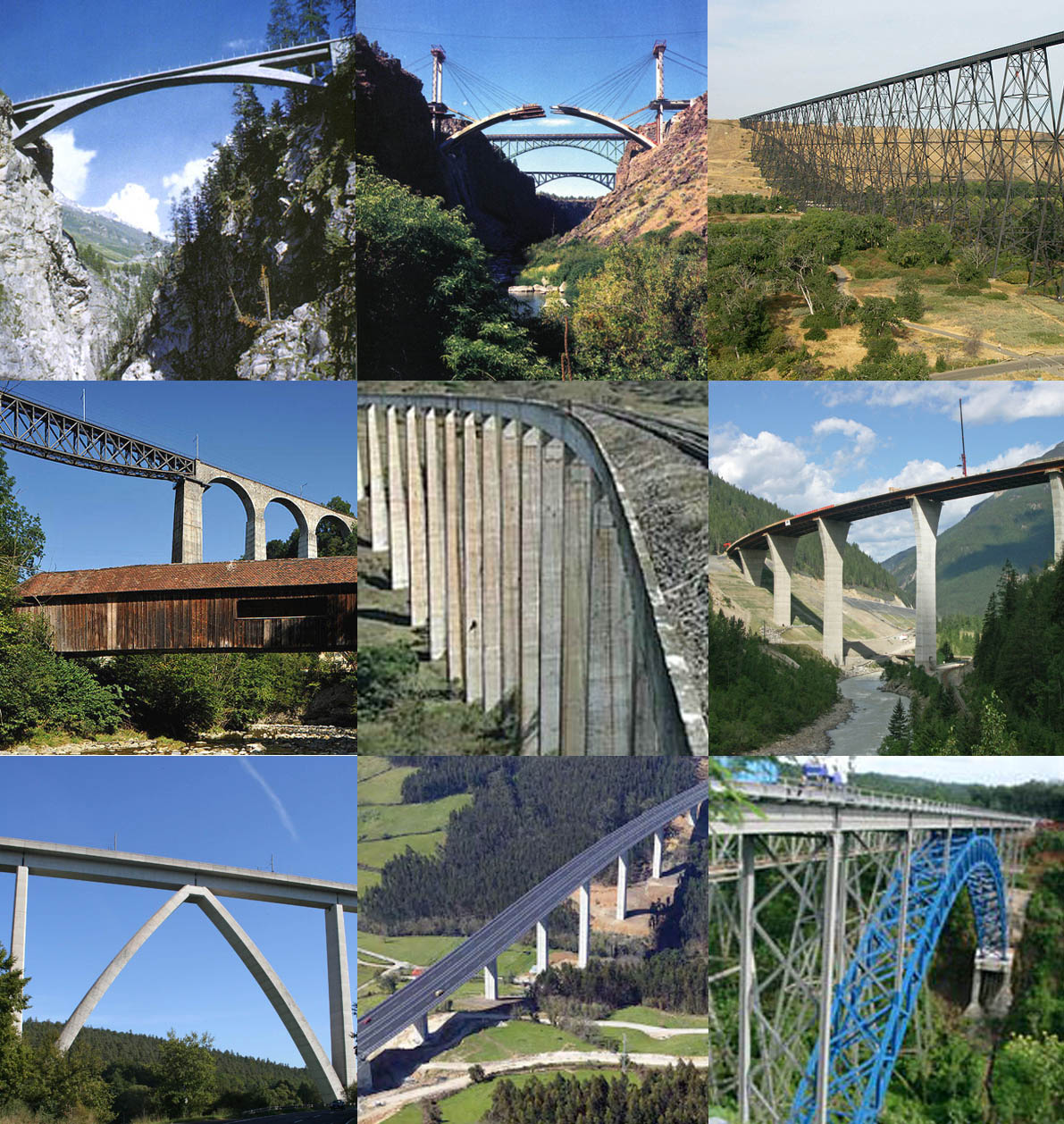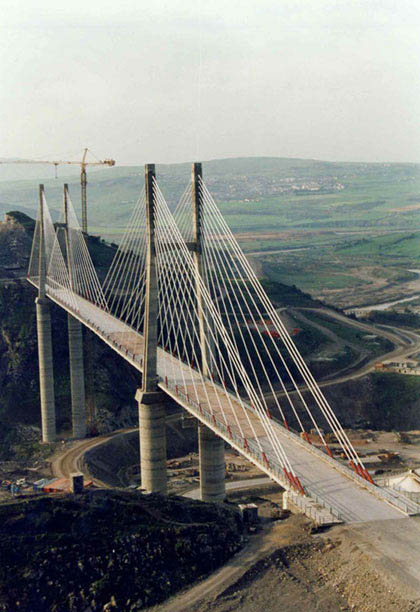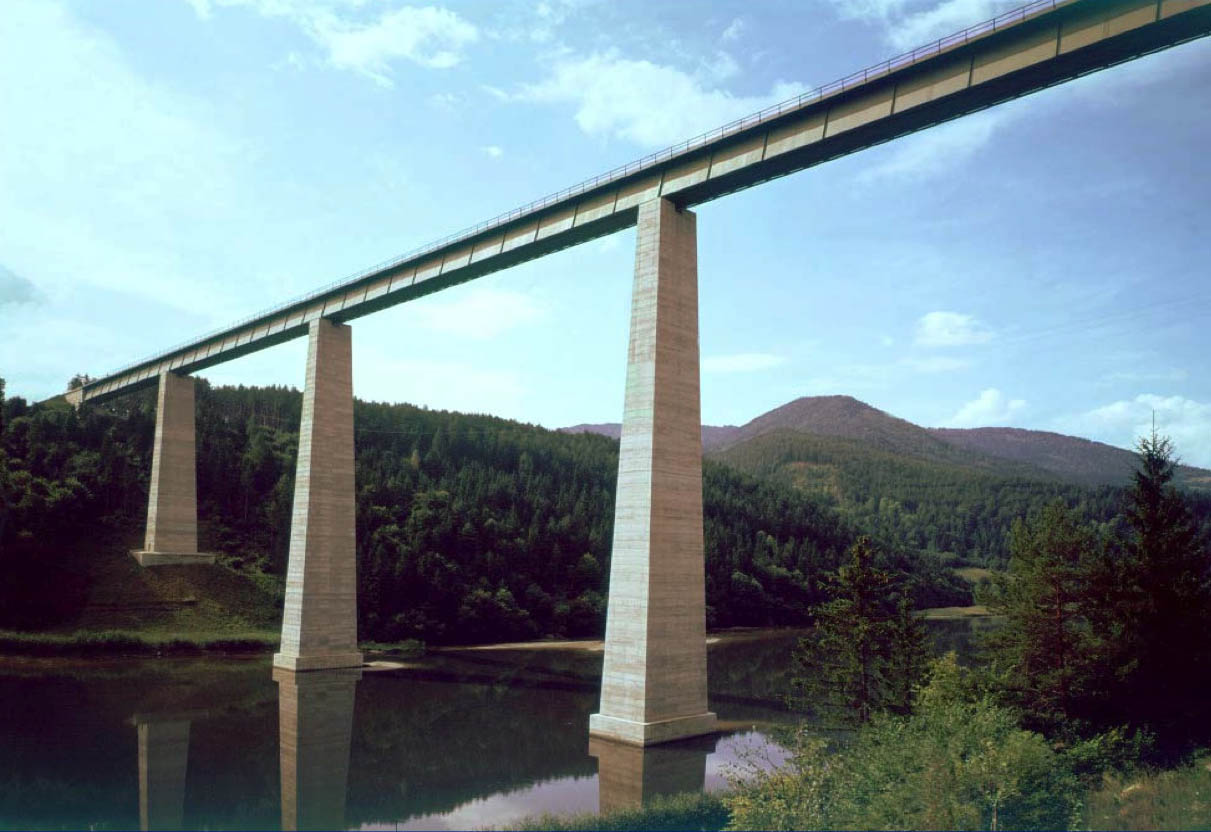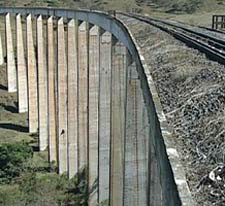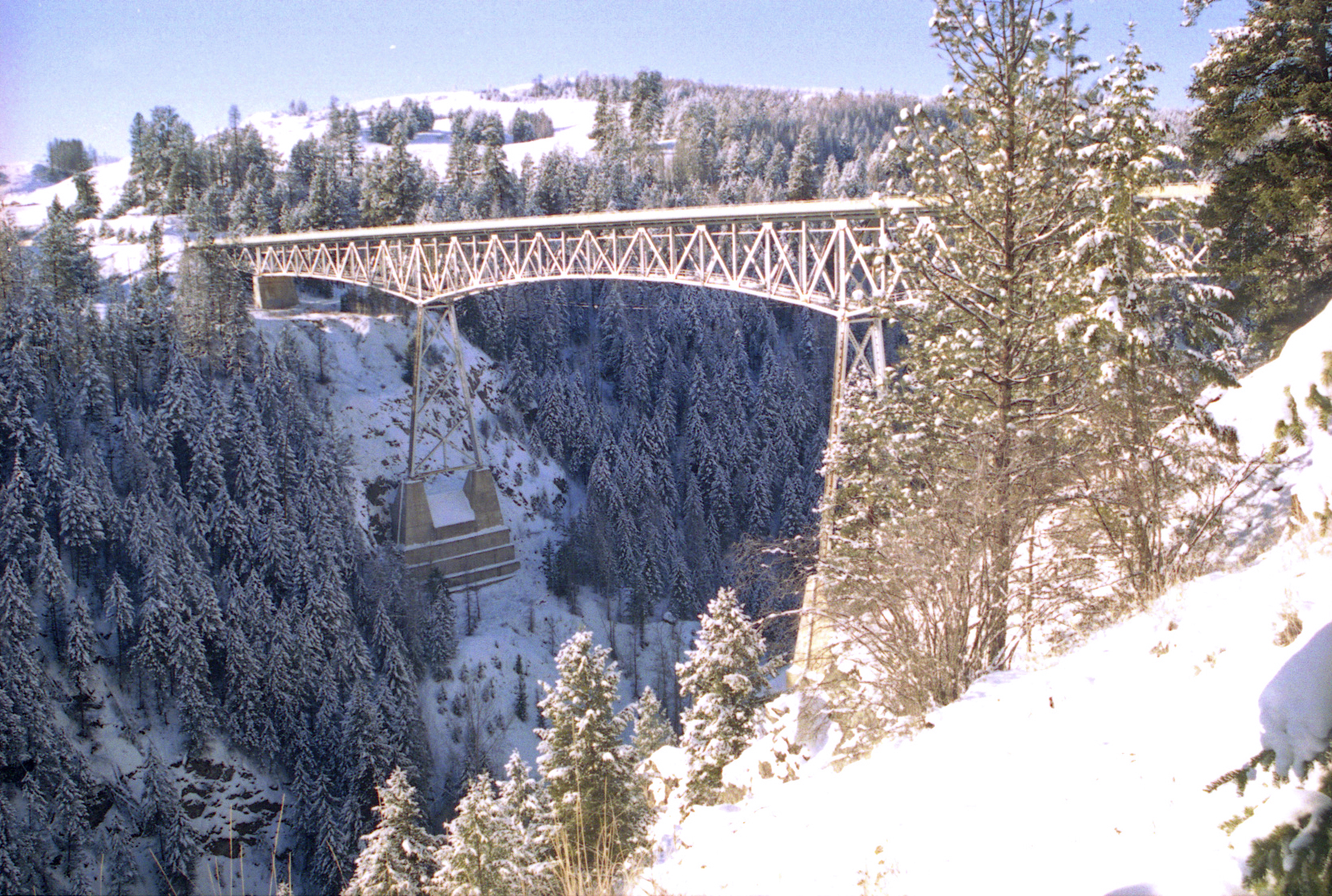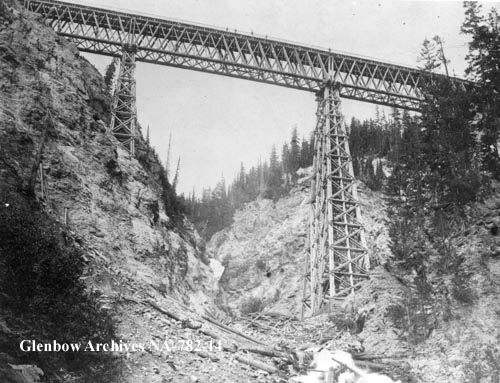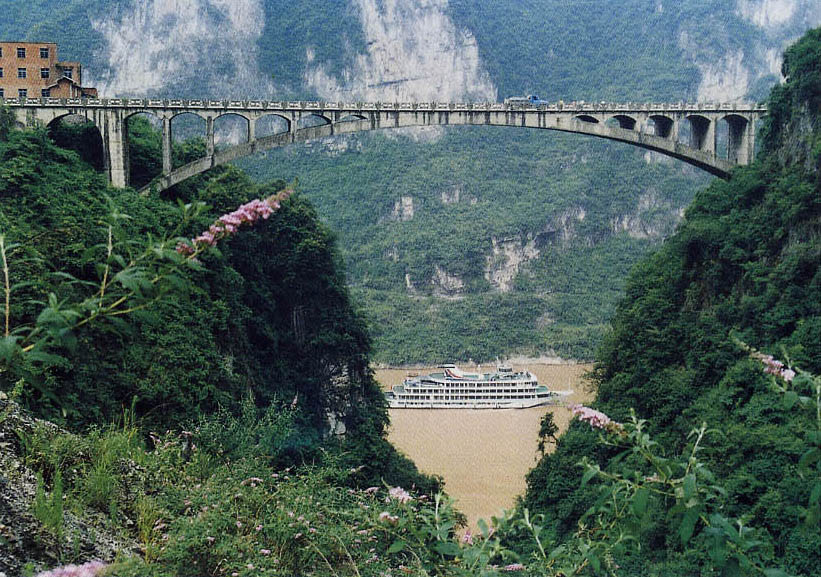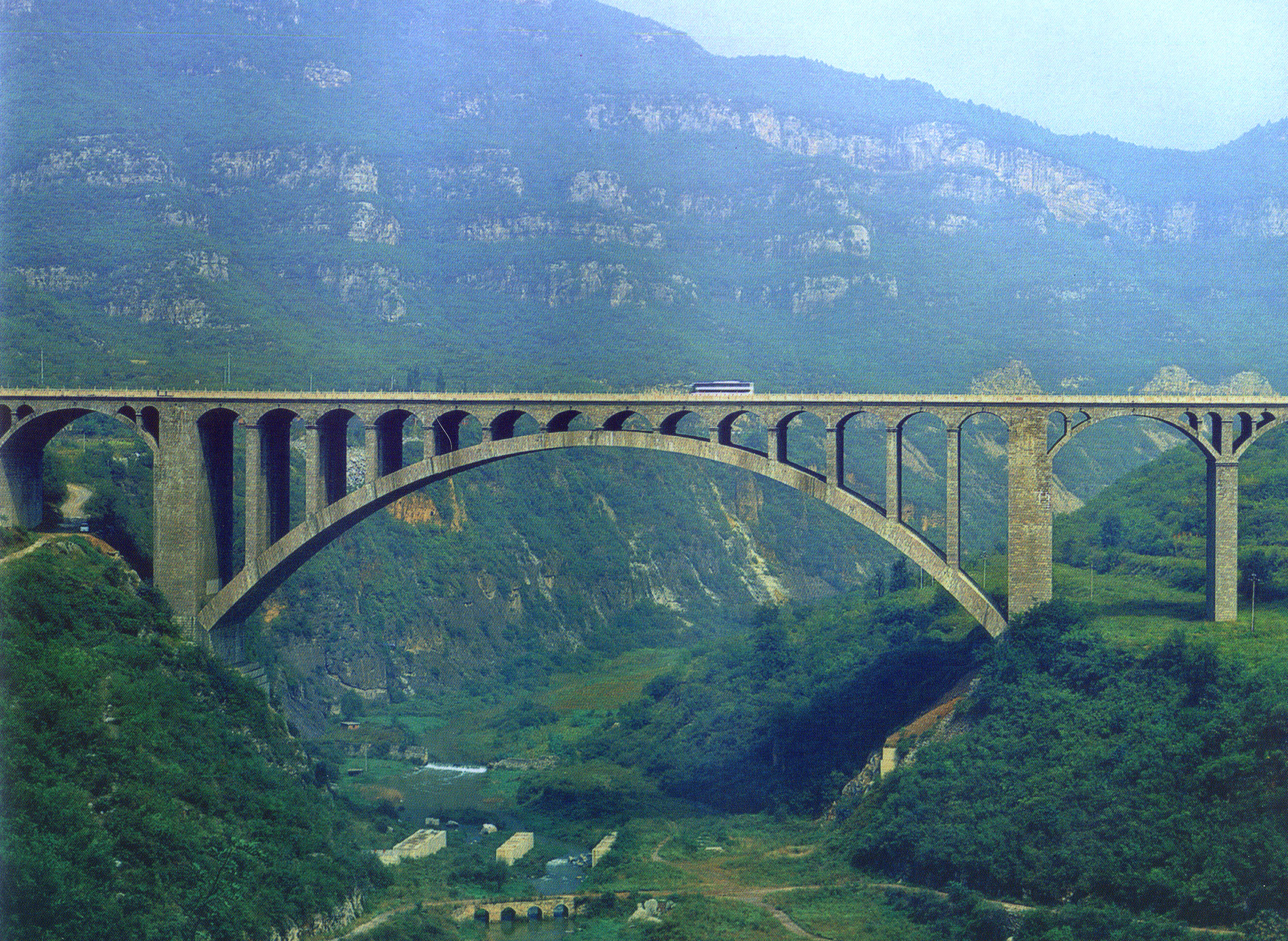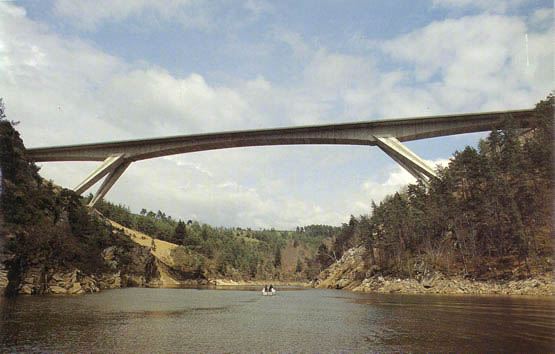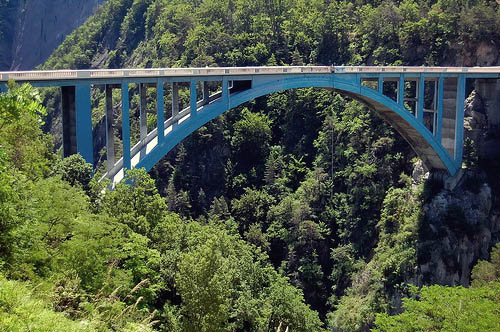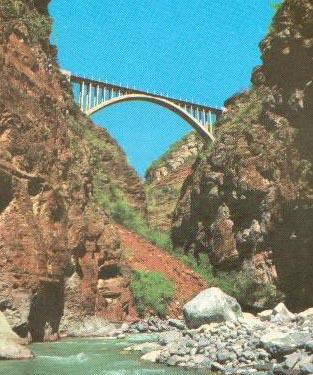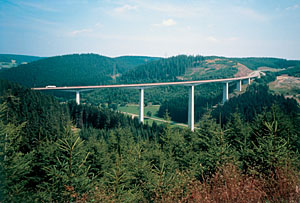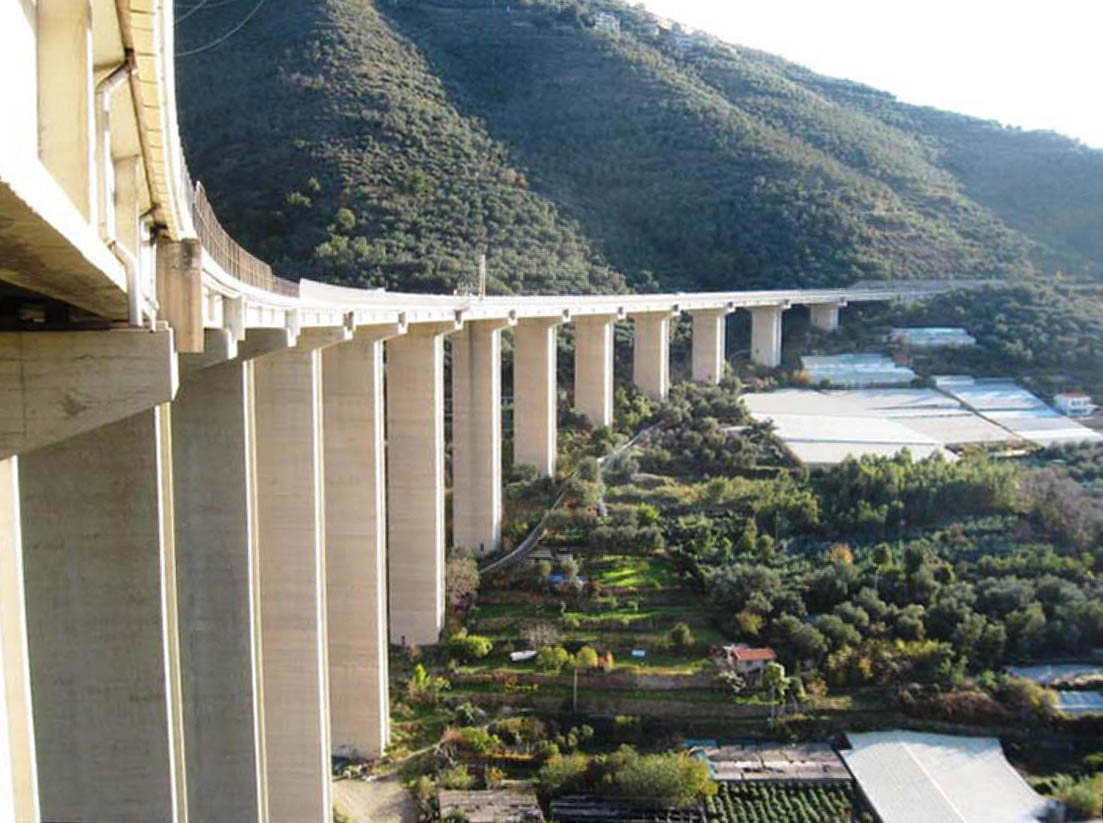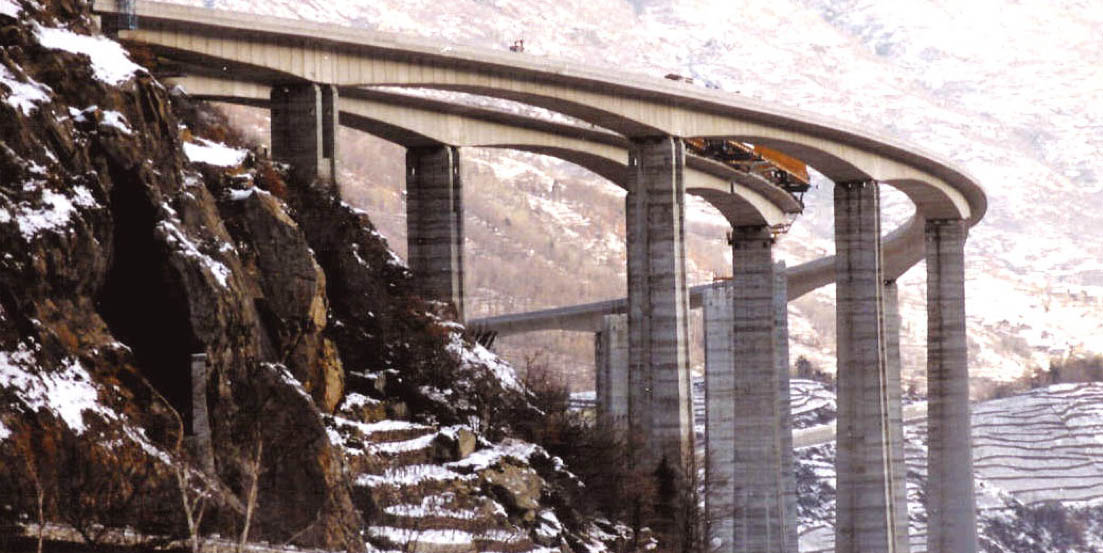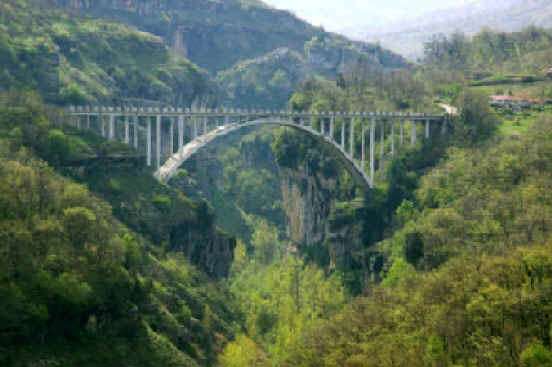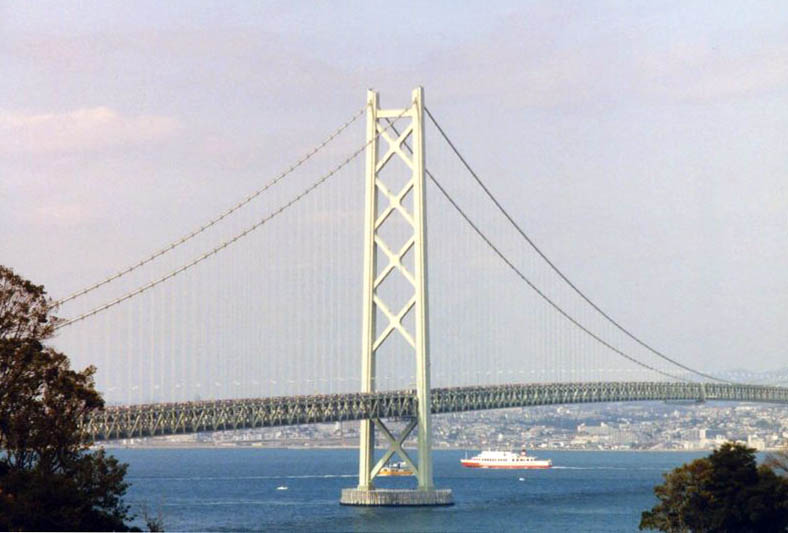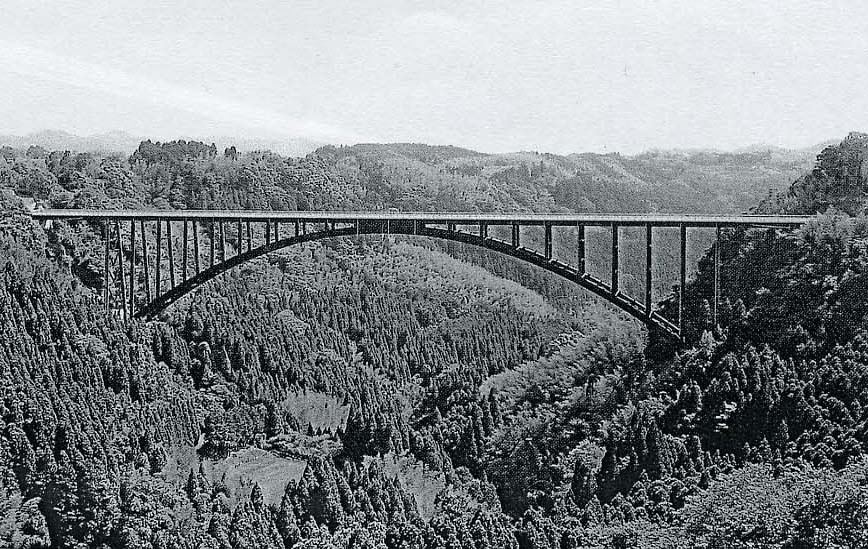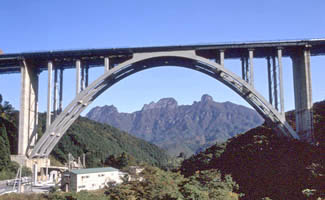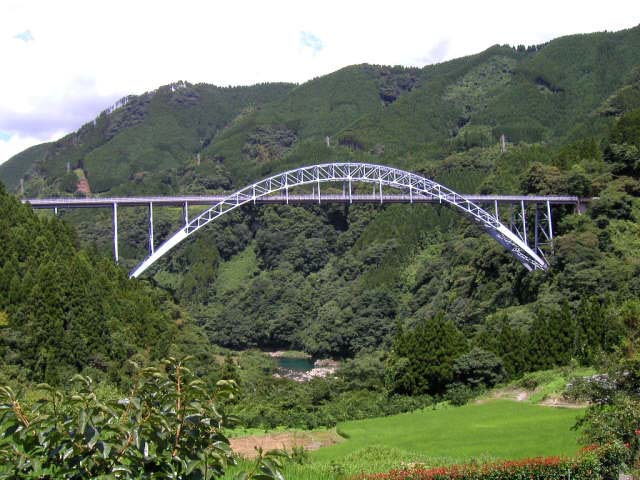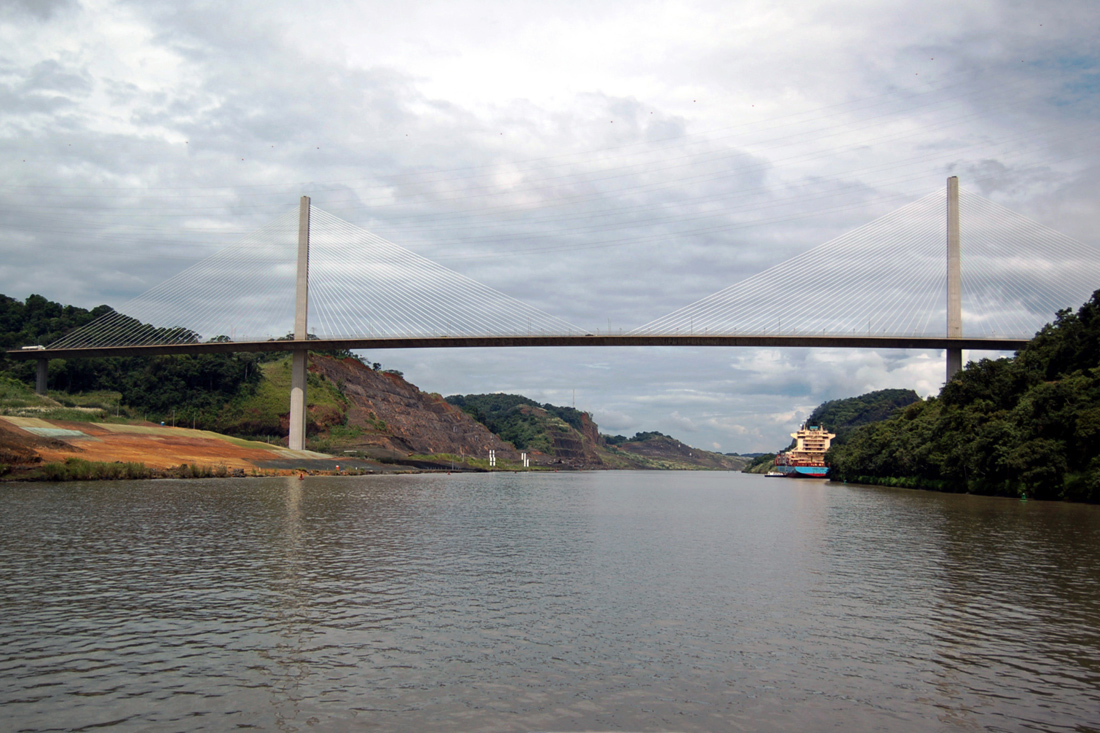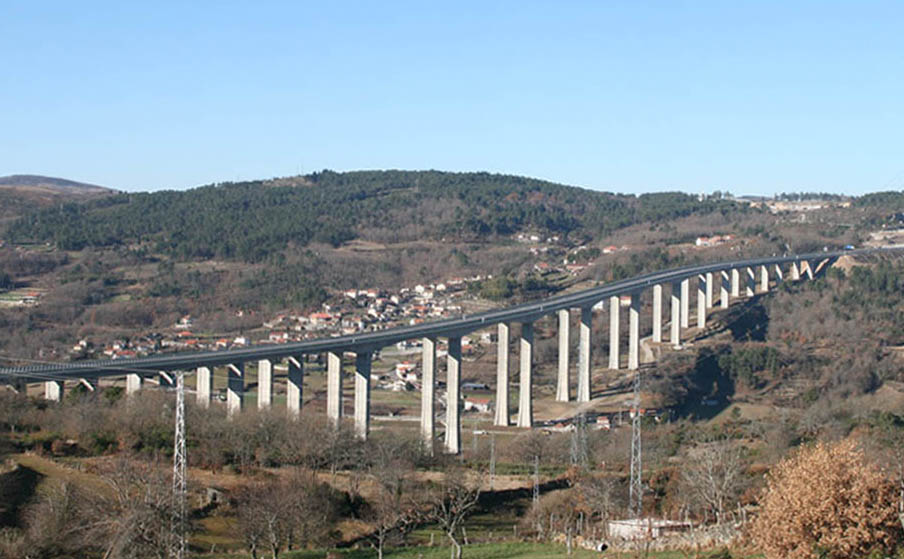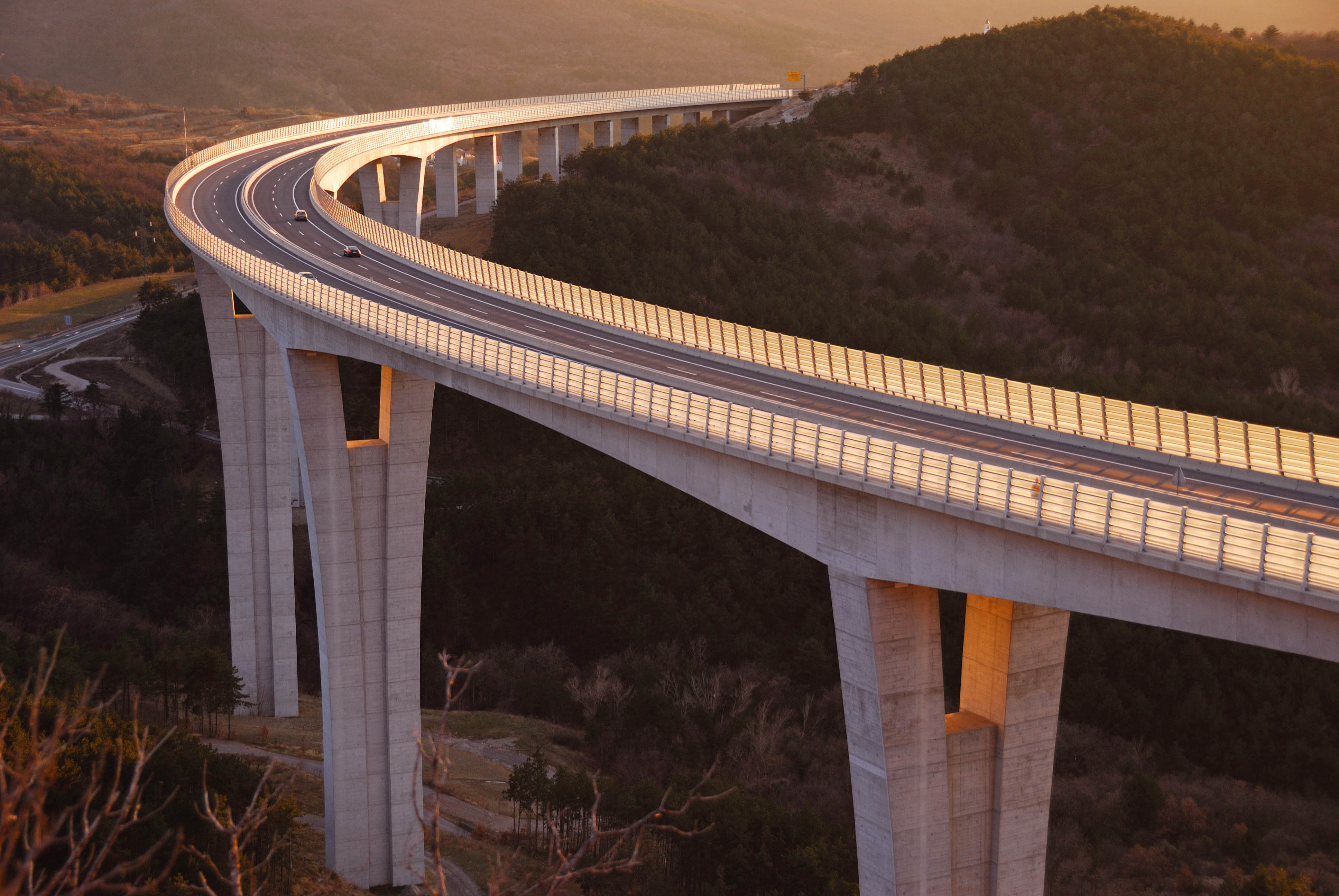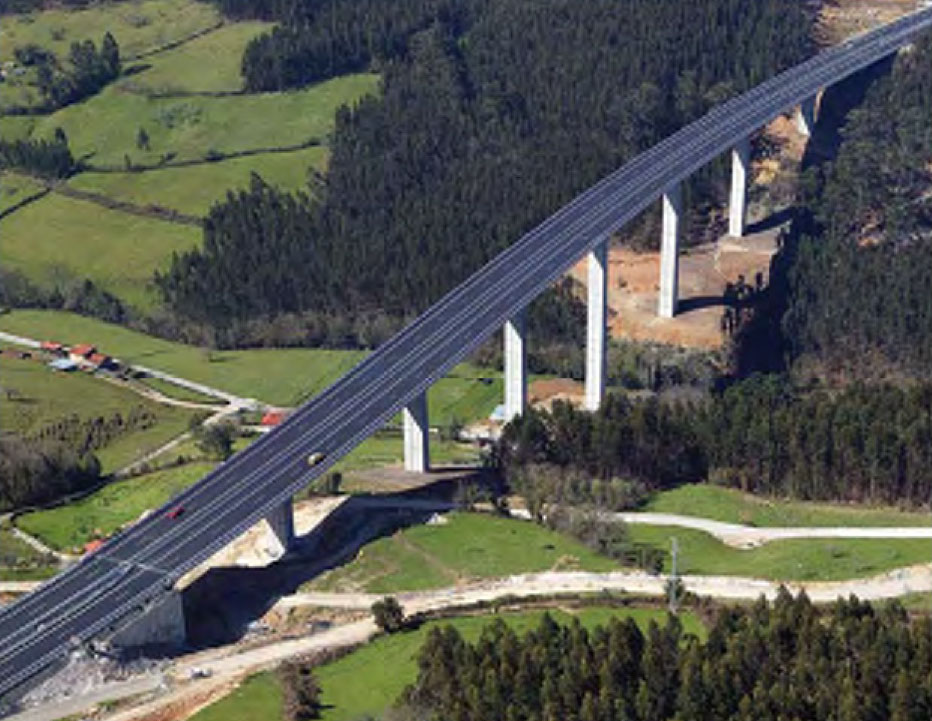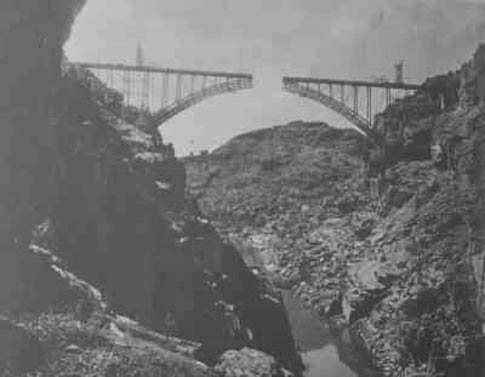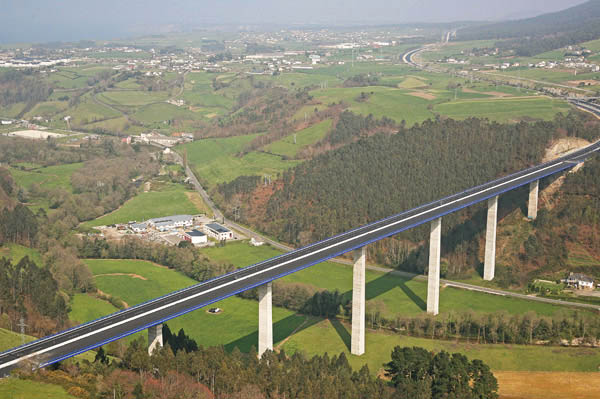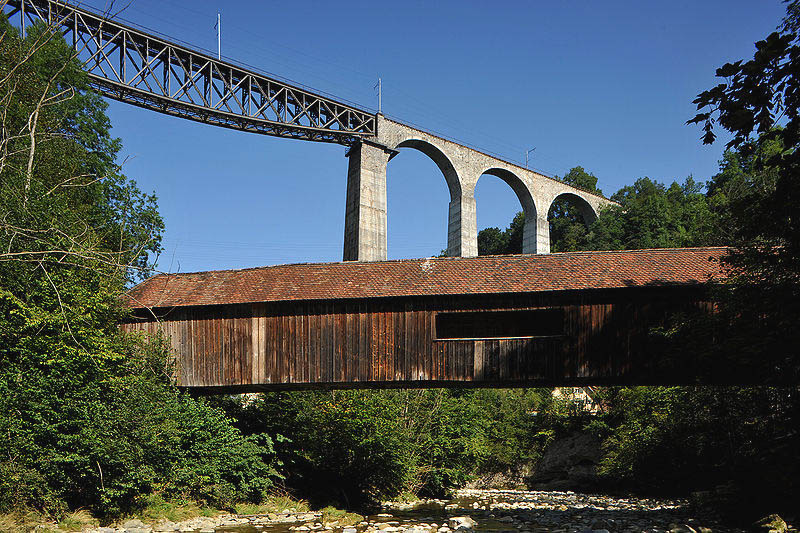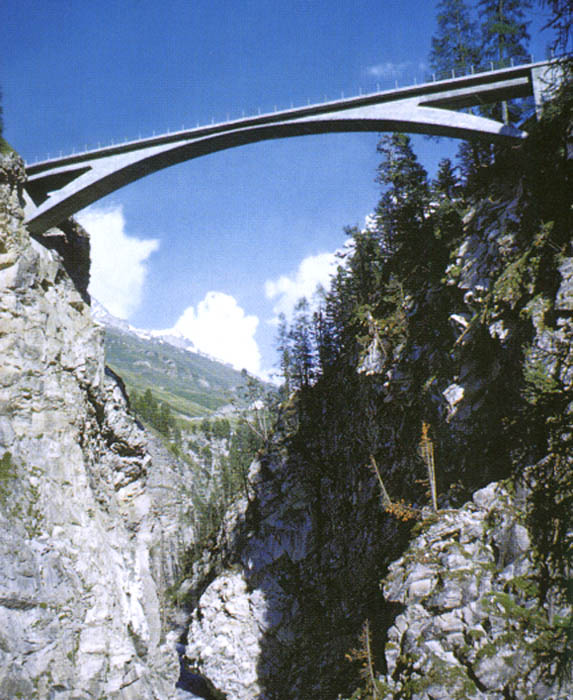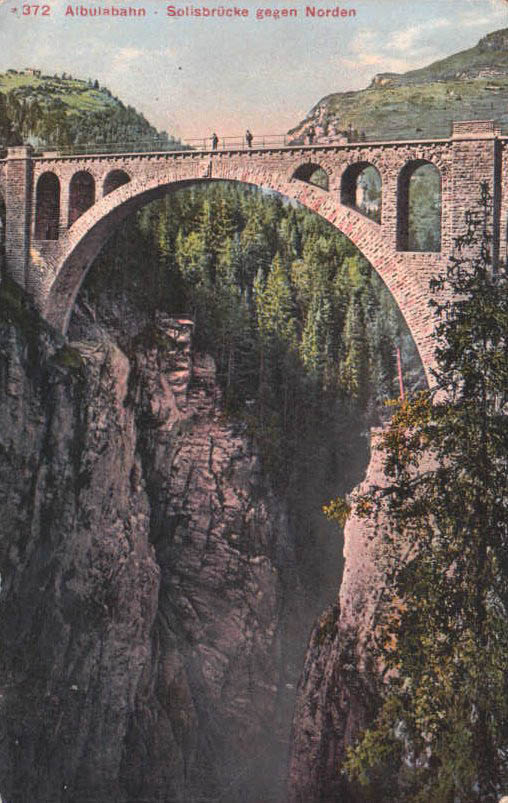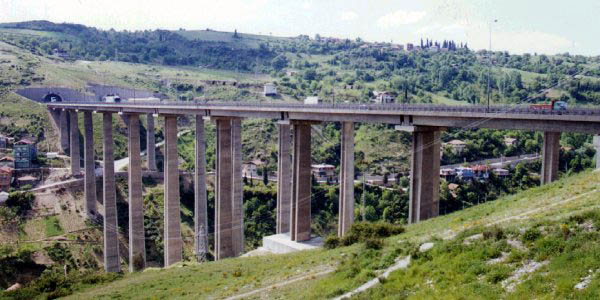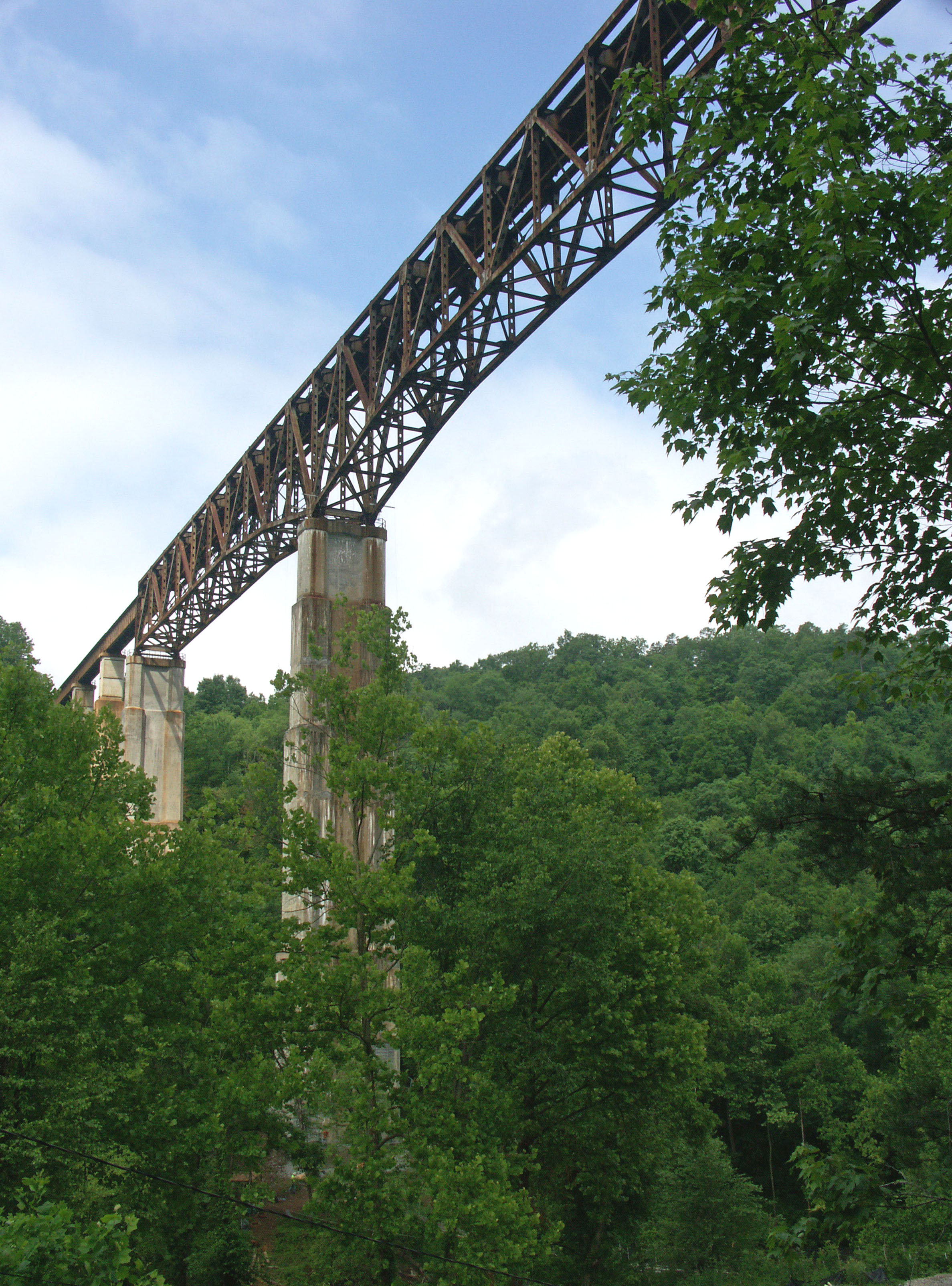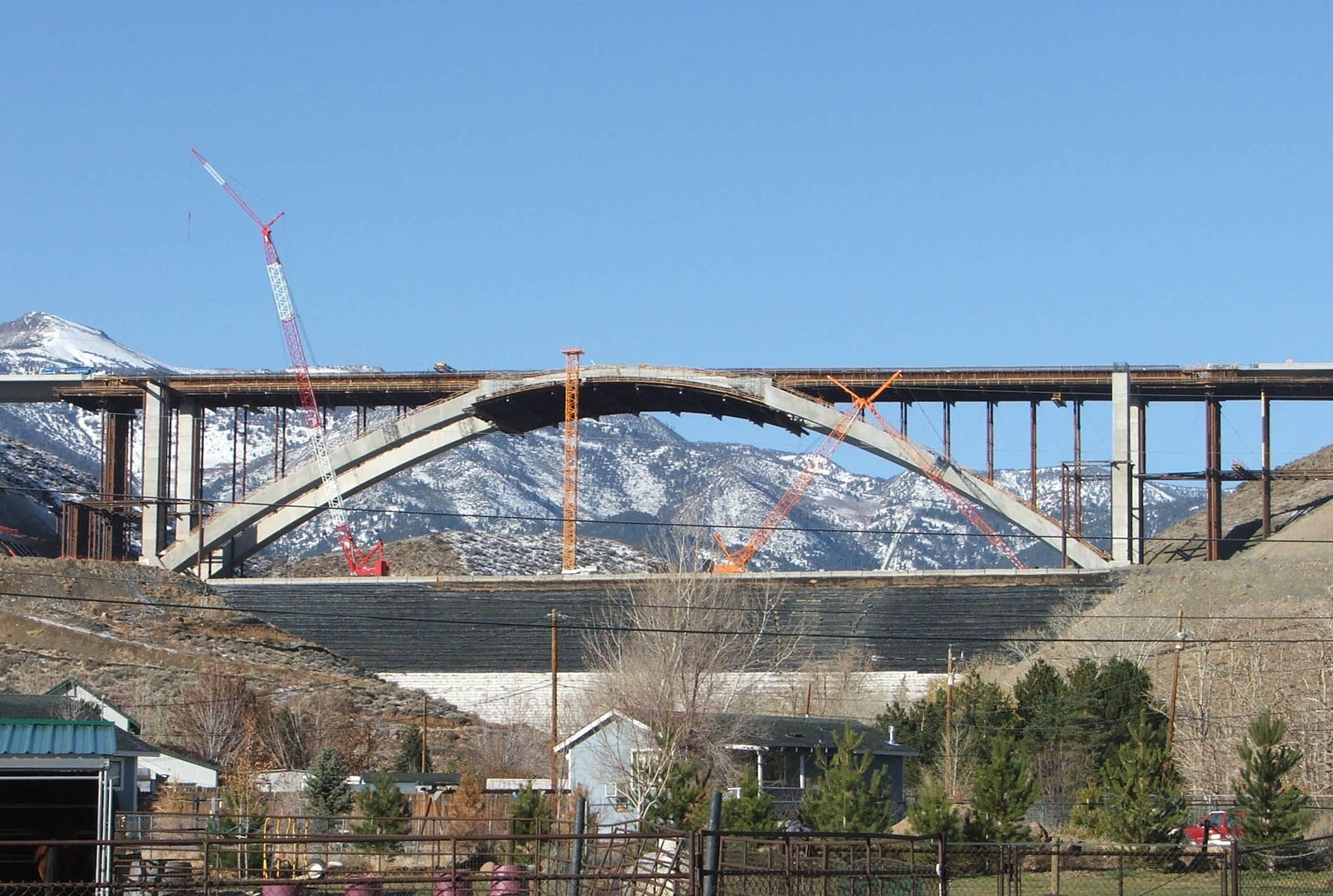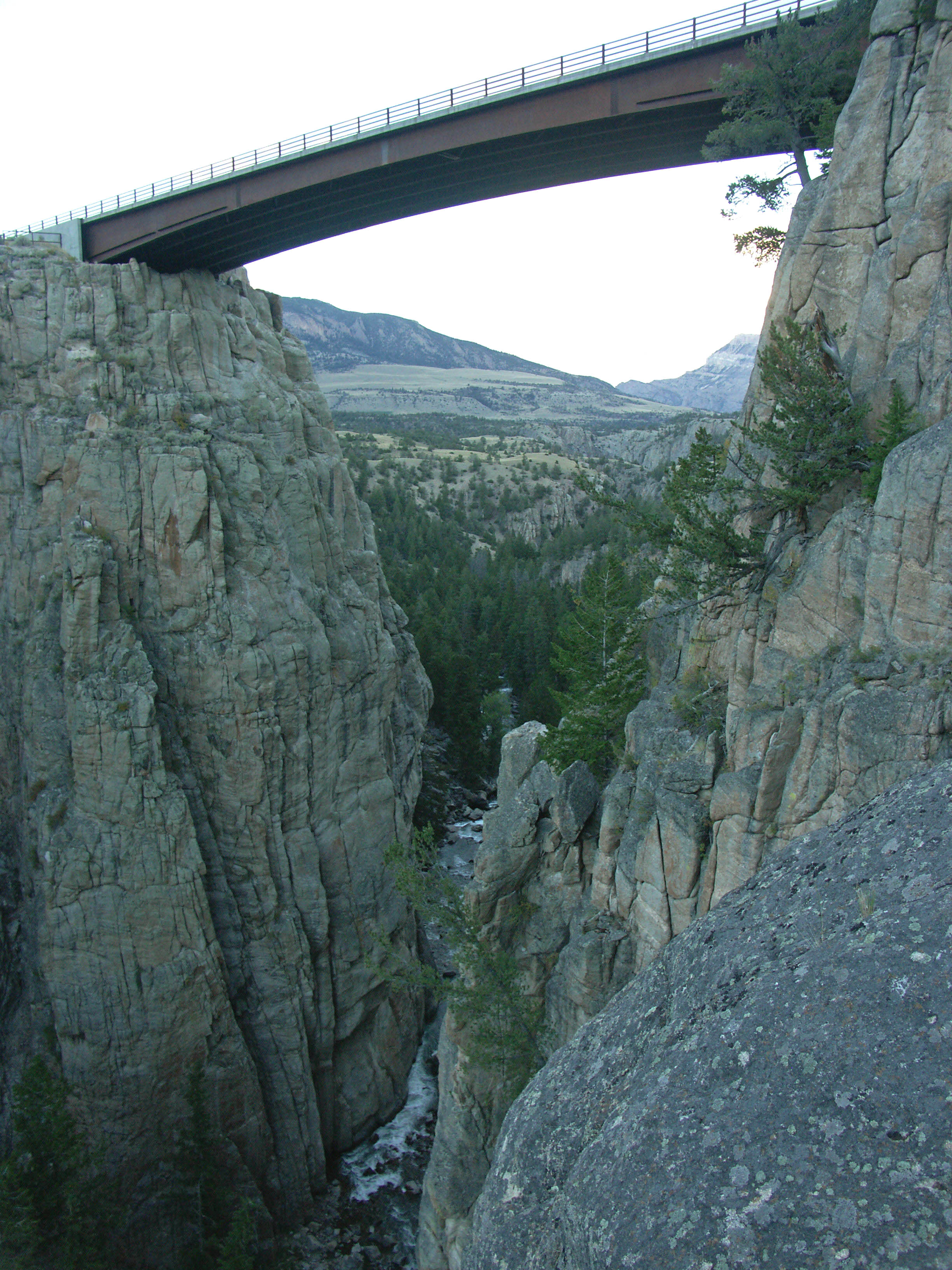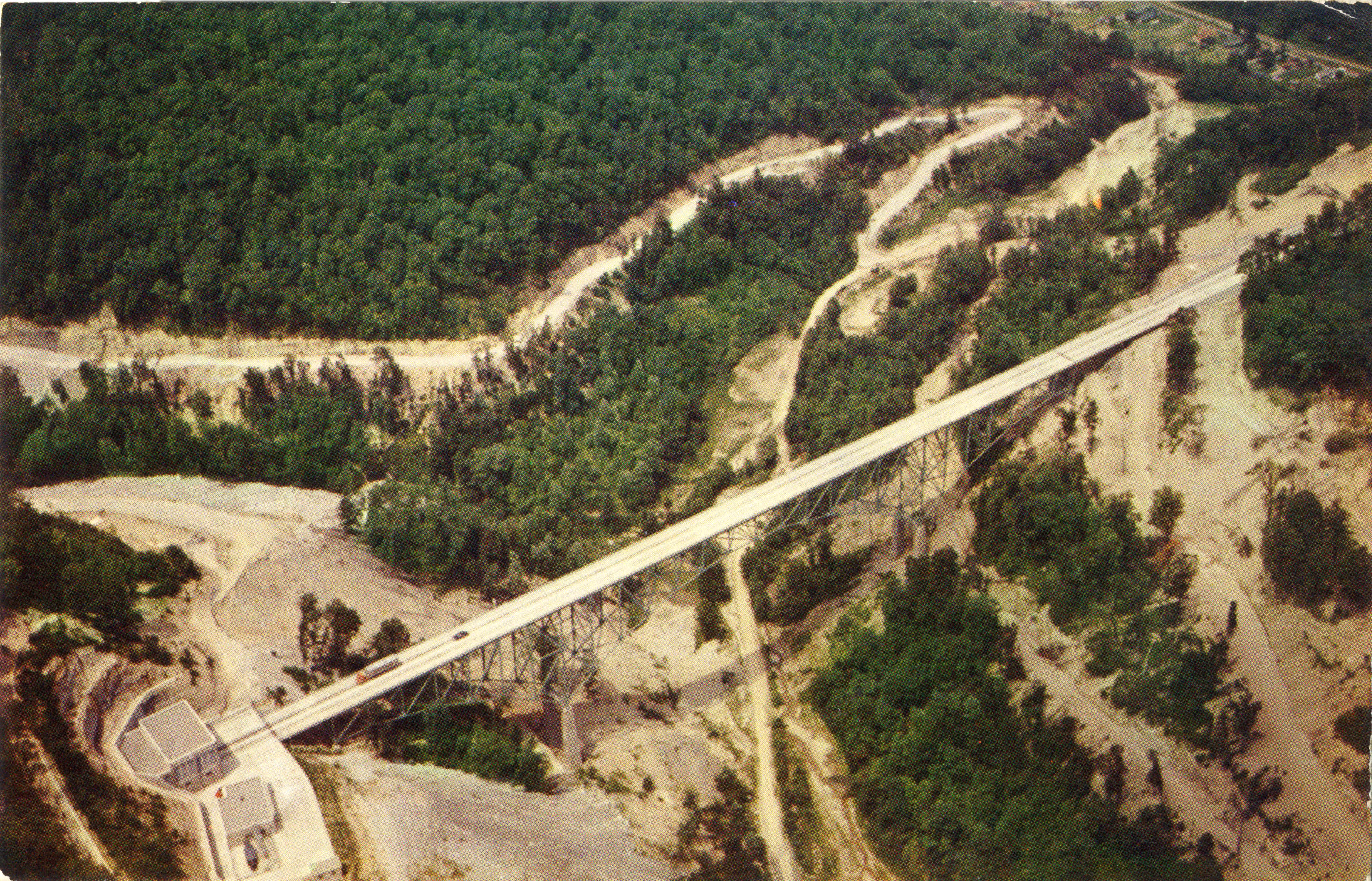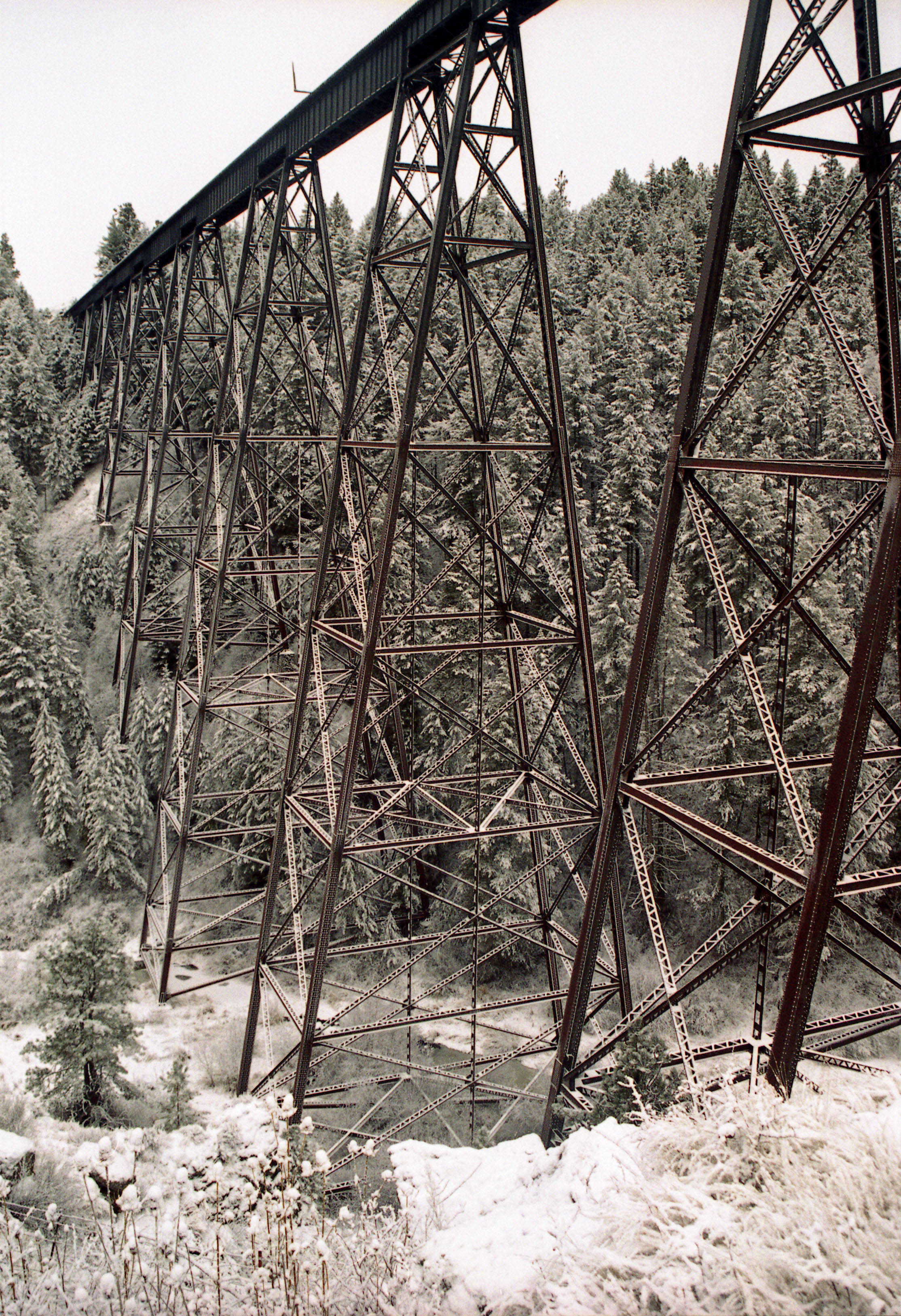Bridges 90 to 100 meters
Welcome to HighestBridges.com
Bridges Between 90 and 100 Meters High
After researching thousands of high bridges from around the world, it was disappointing to exclude so many wonderful spans that either fell short of the 328 foot / 100 meter height threshold or the information was too incomplete or unknown. China and Japan each have at least a dozen bridges over 328 feet / 100 meters that I could not list for lack of an accurate height figure, bridge name or location. As more information comes in on these bridges, I will add them to the list.
For the bridges that were not quite 100 meters, I am listing them below in the hope of someday expanding the website to include all International bridges down to 90 meters / 295 feet in height. Obtaining elevation drawings, images and facts on these structures will take a lot of time and travel. Many of these bridges have heights that will remain a mystery until they can be accurately measured with a laser range finder. Several bridges were included in the 80 to 90 meter range.
To assist in filling in these information gaps, I appreciate any help you can offer. If you are a photographer and live near a high bridge or have some bridge images on your computer from a recent vacation, send them in to www.HighestBridges.com where they can be seen by thousands of bridge fans from around the world. If you are an engineer, contractor or designer who worked on one of the many bridges on this website, I welcome any facts, drawings or construction photos you can contribute. The accuracy of this website can only improve with your help.
Many of the bridge heights below are estimates based on known span lengths and/or photographic analysis and are subject to error.
ALGERIA
Completed in 1999, the Wadi Dib (95 meters high) is a 2-lane cable stayed bridge that was constructed to cross a large artificial lake that eventually formed beneath it from the completion of the Beni Haroune dam just north of Anouche Ali. Designed by Mario Paolo Petrangeli of Italy, the 3-span layout includes a central span of 919 feet (280 mtrs) and two side spans of 364 feet (111 mtrs). The H-frame towers support a prestressed concrete deck 44 feet (13.3 mtrs) wide.
ARMENIA
With the Arpa River gorge cutting straight through the city of Jermuk, it was only a matter of time before a high level bridge would be built. Constructed in 1972, the Arpa River bridge (80 meters high) is a medium sized steel arch with a span of 394 feet (120 mtrs). The steel ribs look a little thin for a bridge of this size but the 2-lane structure has been serving the city well for more than a third of a century.
Located in the capital city of Yerevan, the massive 1950-built Kievyan arch bridge (98 meters high) carries six lanes of traffic across the Hrazdan River in the heart of the city.
Just north of Yerevan is the Davitashen bridge (92 meters high), a steel beam crossing of the Hrazdan River with three 262 foot (80 mtr) spans.
AUSTRIA
Äußere Nösslachbrücke (96 meters high) is the largest and highest of 3 arch bridges in close proximity along a stretch of the Brenner Autobahn. Referred to as the Outer Nosslach bridge, the 558 foot (180 mtr) span arch is located just south of Nösslach while the Inner or Second Nosslach bridge with a span of 361 feet (110 mtrs) is just north of the exit. The highway travels through the famous Brenner Pass - one of the few routes through the Alps between Austria and Italy. The most notable bridge along the highway is Europabrücke, the 623 foot (190 mtr) high beam bridge just south of Innsbruck.
One of the highest footbridges in Europe, the Benni Raich or Arzl i. Pitztal Pedestrian suspension bridge (94 meters high) has unique V-shaped towers that keep the main cables 87 feet (26.4 mtrs) apart at the top. The shallow angle of the hanger cables prevents the triangular truss from moving in the wind. Critical flutter velocity is 195 km/hour while maximum wind speed recorded at the site is 160 km/hour. Designed to carry a wastewater pipeline, the footpath is just 5 feet (1.5 mtrs) wide. The truss weighs in at 46 tons.
Benjamin Raich was one of Austria’s greatest alpine skiers. The famous skier stated that bungee jumping was one of his hobbies. Not surprisingly, the bridge has a permanent bungee operation where you can drop into the beautiful Pitzenklamm gorge. For information visit http://www.club-alpin-pitztal.at/bungy/bungy.htm.
Overlooking the small town of Leoben, the Talübergang Leoben (90 meters high) is one of the few arch bridges on Austria’s spectacular A10 Tauern Autobahn. Just 2 miles (3 kms) to the south is the equally high Talübergang Eisentratten beam bridge. To the north of Leoben about 2 miles (3 kms) is the 100 meter high Kremsbrücke.
One of several tall bridges on the A10 Tauern Autobahn, the beam bridge Talübergang Eisentratten (90 meters high) casts a long shadow over the small town of Eisentratten with a main span of approximately 328 feet (100 mtrs). Just 2 and 4 miles to the north are equally spectacular high bridges at Leoben and Kremsbrücke.
Another beautiful Austrian railway bridge in a picture perfect alpine setting, the Trisanna bridge (88 meters high) has a 394 foot (120 mtr) main span that has been reconstructed several times since the bridge first opened in 1884. The original span was a truss-arch that was first strengthened in 1908 to handle heavier trains. In 1922 the span was converted into a lenticular truss from the addition of an under slung truss chord below the deck. For over 40 years the oval lenticular truss gave the bridge a signature look that made it a symbol of the eastern Arlberg rail line. That finally changed in 1964 when a more conventional tied arch replaced the lenticular truss in a maneuver that only interrupted rail traffic for 10 hours. The bridge is located just south of Pians, Austria.
Constructed in 1964, the Jauntal bridge (87 or 96 meters high) was the last tall European railway bridge to be constructed before the high speed rail craze began in the 1980s. The bridge has become the site of a popular bungee jumping operation. You can find out more here: http://www.bungy.at/de/index_bungee.php There are several Youtube videos like this one: http://www.youtube.com/watch?v=87J007JKSNQ&feature=related
A hidden gem lost in the Austrian Alps, the Angertalbrücke (85 meters high) or Angerschluchtbrücke tram rail arch was constructed in 1905 near the town of Bad Hofgastein. With a main span of 361 feet (110 mtrs) and depth of just 53 feet (16.1 mtrs) above the foundations, this truss-arch is a slender and well proportioned structure. There are reports of a new concrete double track railway bridge bypassing the 100+ year old arch which would then be converted into a road or bicycle bridge. You can read more about the bridge and railway on this German language Salzburg Wiki page: http://www.salzburg.com/wiki/index.php/Angertalbr%C3%BCcke
BRAZIL
Brazil has several tall railway viaducts in the 295 foot (90 mtr) to 328 foot (100 mtr) range including the curving, 1969-built Viaduto Fundão on the Ferrovia Centro-Atlântica, the Viaduto afogador da ligação on the ferroviária Fazenda Alegria-Fábrica and the huge Viaduto Araguari with its rare A-frame span opening. The Viaduto da Geriza is another curving beauty and can be found on the Ramal ferroviário Capitáo Eduardo.
A popular bridge with bungee jumpers, the 1958 constructed Ponte Dom Pedro II (86 meters high) crosses the rocky São Francisco River gorge near Paulo Afonso City in Bahia. A rare 3-hinged polygonal truss-arch, the designer extended the use of trusses to the deck spans as well as the two main pier supports. Two major hydroelectric dams are located just upstream from the bridge.
BULGARIA
Although Bulgaria’s Hemus highway is known far more for the imposing Bebresh Viaduct, the unnamed Viaduct of km 48 (85 meters high) is nearly as impressive with 256 foot (77 mtr) piers and a maximum span length of 459 feet (140 mtrs). The bridge is located northeast of Sofia on the A2 Hemus highway at mile 30 / km 48.
CANADA
The largest conventional trestle railroad bridge ever built, the mile long Lethbridge Viaduct (94 meters high) opened in 1909 across the Oldman river in the southern Alberta province city of Lethbridge. The crowning achievement of the Canadian Pacific railway, the bridge was actually a bypass to the original route that went south across the St. Mary’s river and over numerous coulees on a series of timber Howe truss trestles that were not built to last more than 10 or 15 years and required constant maintenance. A new direct crossing over the Oldman river shaved 5 miles (8.5 kms) off the original route.
Although the design and construction of Lethbridge was similar to many other trestles, the scale was unprecedented. Most tall railroad bridges have trestle towers that span no more than 45 feet (14 mtrs). On Lethbridge they are 67 feet (20 mtrs) long. The intermediate spans of 97 feet (30 mtrs) were also of a length that was rarely exceeded at the time. The use of partial through plate girder spans was also uncommon. By having part of the girder higher than the rail, it acted as a partial wind buffer. Now 100 years old, the bridge is still heavily used and a vital component of CP’s extensive rail network.
One of 3 high bridges built on the new Mica Dam access road along Lake Revelstoke, Carnes Creek bridge (91 meters high) crosses an inlet that was once a crevasse-like gorge before the waters were backed up by the 574 foot (175 mtr) high Revelstoke dam. Constructed in 1982 approximately 2 years before the completion of the dam, the Carnes Creek bridge is a 4-span steel girder crossing with a cantilevered central beam span. Pier number 2 rises 253 feet (77 mtrs) above the south bank of the gorge. Nearby Mars and La Forme creek bridges are also high, rising 190 feet (58 mtrs) above their old creek levels. Without an artificial lowering of Lake Revelstoke, the full height of these 3 bridges will remain forever unseen.
One of the most expensive roads ever built in Canada, the Coquihalla highway 5 is a toll road that extends north through British Columbia from Hope to Kamloops. About 15 miles (24 kms) south of Brookmere is the Dry Gulch bridge (91 meters high), a steel box beam arch completed in 1985 with a main span of 575 feet (175 mtrs). Several hundred feet down the gully are the remains of the Dry Gulch trestle that was part of the famous Kettle Valley railway that once snaked through southern British Columbia before it was abandoned in 1961.
The highest bridge on Canada’s route 3, the Rock Creek Canyon bridge (91 meters high) was completed in 1951 near Bridesville. The 5-span deck truss has a central river span of 309 feet (94 mtrs) that rests on piers supported by layered foundations that look like a wedding cake. In 1992, B.C. engineers Buckland & Taylor renovated the bridge with a wider and stronger deck. Route 3 skirts along the southern border of British Columbia.
The highest arch bridge and the second highest bridge overall on Canada’s 646 mile (1,039 km) Trans-Canada Highway 1, the Nine Mile Canyon or Ainsle Creek Bridge (91 meters high) is a steel truss-arch with a main span of 480 feet (146 mtrs). Located along the eastern slope of the deep Fraser River canyon near Boston Bar, the bridge parallels the CN rail line more than a hundred feet lower down. Constructed in 1958, the bridge was part of an overall improvement to the highway which once crossed Ainsle Creek on a much lower timber bridge. The recently constructed Park (10 mile) bridge east of Golden is the highest bridge on Highway 1 crossing 322 feet (98 mtrs) above the Kicking Horse River.
The highest timber bridge ever built and the second highest bridge in North America at the time of its completion in 1885, the original Stoney Creek bridge (90 meters high) carried the upper line of the Canadian Pacific across a deep gully along its route through what is now Glacier National Park in British Columbia near Rogers Pass. No other railway in the history of North America built as many high timber bridges as the Canadian Pacific did in on its initial run through the Canadian Rockies. Like all of the large bridges on the CP, Howe trusses were used for the main spans. For Stoney Creek, they measured 172 feet (52 mtrs) and 161.5 feet (49 mtrs). Both spans partially rested on a central pier 196 feet (60 mtrs) feet high. Like so many railways of the age, the timber bridges were never meant to be permanent, only a quick way to get the line open before more substantial steel structures could replace them. In 1894 it was finally replaced with a 336 foot (102 mtr) steel arch span. No other timber bridge would ever be built as high as the first Stoney Creek bridge. Nearby Mountain Creek and Surprise Creek were the second and third highest timber bridges on the CP mainline. Steel trestles replaced Surprise Creek in 1894 and Mountain Creek in 1902. For those who were wondering, the Kinzua railway viaduct in the U.S. state of Pennsylvania was the highest North American bridge throughout the 1880s.
A replacement for the famous Howe truss timber bridge of 1885, the 1894 Stoney Creek arch bridge (90 meters high) spans 336 feet (102 mtr) between two rocky cliffs in Glacier National Park in British Columbia. Years later the bridge was reinforced for heavier locomotives by adding another truss-arch rib next to each of the two original ribs as well as replacing the deck truss spans with smaller girder spans and increasing the number of spandrel supports. The arch uses 524 tons of steel out of a total weight of 771 tons.
A big, beautiful blue arch, the Paulson bridge (84 meters high) is located on British Columbia’s east-west highway 3 which runs just north of the U.S. border. The main arch has fixed ends and consists of two steel box girder ribs that span 520 feet (158 mtrs). The bridge crosses over McRae Creek as well as the old grade of the famous Kettle Valley railway which has now become a popular rail trail. You can see the bridge from below by accessing the Kettle Valley trail. Drive 2 miles (3.2 kms) north on route 3 and turn left onto a dirt access road that leads back towards McRae creek. The Paulson bridge is located 10 miles (16 kms) north of Christina Lake, British Columbia.
CHINA
中国低于100米高的桥梁
Qingganhe (97 meters high) is another bridge created to cross a tributary flooded by the massive 3 Gorges reservoir in Western China. The large concrete filled steel tubular arch spans 840 feet (256 mtrs) in the mountains near Zigui, Hubei. The span was completed in 2000.
青干河大桥97米高是在中国西部地区跨越三峡大坝淹没区的一条支流的另一座桥梁。这座跨度256米的钢管混凝土特大桥位于湖北秭归县境内,与2000年建成。
The third highest bridge in Guangdong province, the Jinkeng bridge (95 meters high) is located on the Yingde-Foshan highway. Dubu Bridges #1 and 2 are the highest in the province.
广东省第三高的大桥,金坑大桥高95米位于英德-佛山公路上。杜步大桥一号桥和二号桥是该省最高的两座桥。
The Bincao Hillock (90 meters high) is the third highest single tower cable stayed bridge in the world after Japan’s Ayunose bridge and the Qing Jiang bridge near Enshi, Hubei.
斌草山大桥90米高是继日本的Ayunose (鮎ノ瀬=あゆのせおおはし)桥和湖北恩施的清江大桥之后的世界第三高度的独塔斜拉桥。
Located somewhere along the expressway between Chongqing and Hunan, the Xisha River bridge (90 meters high) is a steel through arch with concrete filled steel tubular ribs. The height is a very rough estimate and may be quite a bit higher or lower. The main span is 623 feet (190 mtrs).
位于重庆至湖南的高速公路的某个位置的下沙大桥90米高是一座钢管混凝土拱桥。这座桥的高度是估计出来的,也可能会更高一些或者较低一些。主跨190米。
One of the highest bridges in Fujian Province, the Shikongshan viaduct (90 meters high) consists of two long bridges that snake over a deep river valley near Longyan. Completed in 2002, the longest spans are 509 feet (155 mtrs).
福建省最高的桥梁之一,石崆山高架桥90米高,其实是由两座很长的桥组成(类似于广东省的杜步大桥一号桥和杜步大桥二号桥),蜿蜒跨过龙岩附近的深谷。2002年建成,最长的桥跨为155米。
Completed in 1973, the Gangouzi (85 meters high) was the highest road bridge in China for several years before the Yesanhe arch opened in 1977. One of the most photogenic of China’s high arch bridges, the 315 foot (96 mtr) prestressed concrete box rib span retains the look of a traditional Chinese stone arch from the small arch spandrels just below the deck. Perched across a gully some 200 meters above the north side of the Yangtze River, the bridge was largely bypassed by the construction of the TGP highway located about 1km north. The easiest way to reach the Gangouzi bridge is by pulling over within a short gap located between two long tunnels on the Three Gorges Project highway and walking south on a dirt path. The gap is located midway between Yichang and the 3 Gorges dam. This spot can be a dangerous place to pull over and park so be careful!
1973年建成,干沟子大桥85米高,在1977年野三河拱桥开通之前,是中国最高的公路桥。作为在中国最上镜的混凝土拱桥之一,96米跨度的预应力混凝土箱型拱桥,保留了中国古典石拱桥的桥面之下建有很多小拱圈的造型。高耸在长江北岸一条溪谷之上200多米高处,这座桥几乎与背面1公里远处的TGP专用公路并行。要想到达干沟子大桥最好的方法,就是在三峡工程专用公路上的两个隧道之间的很窄的山谷处停车,然后走过一条十分泥泞的小路就能到达。要停车位置的山谷大概在宜昌和三峡大坝之间的中间一段,这里因为隧道的缘故,停车很危险,可得小心停车。
The longest span stone or masonry bridge in the world, the Danhe arch bridge (82 meters high) was completed in 2000 with a heavy, herculean main span of 479 feet (146 mtrs). The main rib supports 14 spandrel spans with a wall to wall distance of 31 feet (9.4 mtrs). Seven approach spans make up the rest of the structure with clear spans of 98.4 feet (30 mtrs). The massive rib was constructed upon a huge steel scaffold-like centring. The bridge is located about 15 miles (24 kms) east of Jincheng in Shaanxi province.
世界上最大跨度的石拱桥(圬工拱桥),丹河大桥(82米高)在2000年建成,厚重、巨大的主跨长146米。主拱圈上还有14个小拱圈,间距个9.4米。此外大桥还有七孔引桥,净跨30米。巨大的主拱圈建在庞大的高空排架式钢脚手架上。大桥位于陕西省的晋城市以东15英里(24公里)处。
COLOMBIA
One of two tall bridges on Colombia’s Autopista Bogotá-Villavicencio, the Puente Chirajara (95 meters high) crosses a V-shaped canyon creek on an alignment that curves nearly 90 degrees from one end of the bridge to the other. The 2-lane deck is supported on two steel girders in a box beam configuration that traverses 4 spans, the longest extending 309 feet (94 mtrs) between piers. The foundation of pier 1 extends approximately 148 feet (45 mtrs) underground.
Located along the Pan-American Highway, the Puente Juanambu (90 meters high) is a high prestressed concrete beam bridge with a main span of 295 feet (90 mtrs). The bridge is located somewhere between Pasto and Popayan.
COSTA RICA
Located right next to the famous Rio Grande Railway bridge northwest of San Jose, the Rio Grande River road bridge (96 meters high) is a 2-lane prestressed concrete beam bridge.
CROATIA
One of Europe’s higher pedestrian bridges, the Pazinska Jama footbridge (90 meters high) is a prestressed concrete beam bridge with a main span of 287 feet (87.5 mtrs) and a total length of 379 feet (115 mtrs). Located in the town of Pazin-Istra, the bridge was completed in 1993.
The Maslenica bridge (90 meters high) is a beautiful new concrete arch bridge that was a replacement for a 1961 era steel arch that was destroyed in the last Croatian War. Of the more than 50 bridges that were destroyed on the Maslenica Highway, the crossing of the Maslenica Strait was the most important as it severed the North and South parts of the country. The new bridge was built on a new alignment with a main span of 656 feet (200 mtrs) composed of a fixed double cell arch rib supporting a deck with a width of 67 feet (20.4 mtrs) to handle future 4-lane highway traffic. The concrete arch was built using the stayed cantilever method. Opened in 1997, the final touches included a decorative new lighting scheme that accentuates the structure at night. The bridge was designed by Vinko Čandrlić, Jure Radić and Zlatko Šavor of the Structural Department of the Zagreb Faculty of Civil Engineering.
FRANCE
Located just downstream of Eiffel’s famous Garabit Viaduct, the A75 crossing of the Truyère River is a welcome next door neighbor that arrived in 1993. The largest concrete frame bridge ever built, the main span measures 641 feet (195.5 mtrs) between hinges. The deck is 262 feet (80 mtrs) above the full reservoir and 322 feet (98 mtrs) above the old river level. During construction, the angled strut legs of this massive span were supported by an additional vertical pier that was removed once the span was completed. The Garabit Viaduct can be seen from an exit and overlook just north of the river crossing near St. Flour in the Auvergne region of France.
One of the highest road bridges in France at the time of its completion in 1887, the L’Abime bridge (94 meters high) crosses over the deep chasm of the Chéran River in Gruffy, France. Designer and engineer Ferdinand Arnodin would go on to build the world’s highest bridge in Constantine, Algeria called the Sidi M’Cid.
The use of a mixed cable support system combining suspension cables for the center of the span and cable stays for the deck sections near the towers was not common outside of France and was not used on a major suspension bridge for at least half a century until 1997 when the Wujiang bridge opened in Wujiang, Guizhou province, China. In North America, the only large suspension bridges with cable stays are the Brooklyn bridge in New York, the Roebling bridge (Cincinnati-Covington) in Cincinnati, Ohio and the Wheeling bridge, also in Ohio.
As an engineer, Arnodin would became most famous for designing 9 of the 20 transporter bridges ever built. Three of these rare transportation structures still exist and retain his signature mix of suspension and cable stays.
One of the highest railway bridges in France, the Viaduc d’Evaux-les-Bains (91 meters high), is a classic French wrought iron truss bridge of the era. Similar to the Viaduct de Fades but on a smaller scale, the Bains consists of two massive masonry piers that support three lattice box beam spans 27 feet (8.3 mtrs) deep. The central Tardes River span is 343 feet (104.55 mtrs) long. In January of 1884, a strong wind knocked over a portion of the bridge still under construction.
The viaduc de Rochers Noirs (90 meters high) is a rare French railway cable stayed bridge not unlike the Cassagne bridge that was built several years earlier by Gisclard. Viaduc des Rochers Noirs was constructed by the famous French engineer Ferdinand Arnodin who had designed the world’s highest bridge - the Sidi M’Cid in Constantine, Algeria - in the same time period. The design is actually credited to Maret. Unlike most cable stayed bridges, the stays of the Rochers Noirs do not terminate in the deck but continue to travel horizontally a few feet above the deck until they reach a ground anchorage at the far end of the bridge. The steep slope on one side of the bridge required a masonry tower 150 feet (45.56 mtrs) in height. The main span is 459 feet (140 mtrs). The bridge was originally known as the bridge of Lapleau (Correze) and is the highest structure on the line connecting Tulle to Ussel. Railway traffic finally stopped in 1959 and in 1983 the bridge was opened for pedestrians.
Located 1 mile (1.6 kms) south of La Mure in France’s beautiful Rhône-Alpes region is the Ponsonnas arch bridge (90 meters high). Originally built in 1863 as a suspension bridge, it was replaced with a concrete arch in 1941 that was designed by the famous French engineer Albert Caquot. The original suspension bridge towers assisted in the construction of the new arch. Ponsonnas is a popular bungee site. You can find out more here: http://www.vertigeaventures.com/xsse.htm
Also in the La Mure region and not to be missed is the 110 meter high Roizonne arch bridge. Originally a train bridge, the span was eventually converted to road use. Also referred to as the Pont de la Mure, the main arch of 244 feet (74.44 mtrs) is a semicircle with 4 smaller arches above the spandrels on either side.
The La Mure region has 3 other high bridges worth visiting. 5 miles further west, a suspension bridge along route D34 crosses at least 164 feet (50 mtrs) over the L'Ebron arm of the Lac Monteynard-Avignonet reservoir. Just downstream of the D34 crossing is the Passerelle L'Ebron, one of two high footbridges that cross over the Lac Monteynard-Avignonet reservoir. The other is the Passerelle Himalayenne over the Drac and located 4 miles (6 kms) southwest of La Mure at the small town of Mayres-Savel. Both are at least 164 feet (50 mtrs) above the water - even higher if the reservoir level is down.
One of those mountain hugging snakelike viaducts that are so common in France, Austria, Germany and Italy, the Nantua Viaduct (90 meters high) was originally built as a 2-lane bridge in 1988. A second viaduct was added to the first one in 1996. Constructed in the traditional balanced cantilever method, the main spans are 410 feet (124 mtrs) with a maximum pier height of 282 feet (86 mtrs). The west end of the bridge terminates into a tunnel while the east end is connected to the lower but nearly as long Viaduc de Neyrolles.
The highest footbridge in France (excluding the converted Charles Albert suspension bridge), the Passerelle Holzarte (90 meters high) is a small suspension bridge that was constructed in 1920 near Larrau, France just a few miles from the border of Spain. Some reports have a height of more than 100 meters but until I can measure it, I will leave it in the sub-100 meter category.
One of the highest road bridges in France at the time of its completion in 1889, the Pont Baldy sur la Cerveyrette (85 meters high) was a truss arch with a span of just 171 feet (52 mtrs). Located near Briancon, it would seem the bridge was removed for the construction of the Pont Baldy dam in the 1960s.
Threading in and out of tunnels and across several high bridges on its way towards the Italian border, the A8 was a challenging highway for the French to build. The Viaduc du Rank (85 meters high) near Gorbio is the second highest bridge on the route after the Magnan Viaduct and has piers with a similar style. The spans are approximately 148 feet (45 mtrs) in length.
The highest water aqueduct ever built in France, the colossal Pont de Roquefavour (82 meters high) was completed in 1847 near Ventabren, France. The largest structure of the Canal de Marseille, it was declared a National Monument in 2005. You can read all about the history of the canal here: http://fr.wikipedia.org/wiki/Canal_de_Marseille.
A one-of-a-kind cable stayed railway bridge, the Pont Gisclard or Pont Cassagne (80 meters high) was built in 1909 along a narrow gauge railway in the mountainous Eastern Pyrenees region of France. Bridge engineer Gisclard’s bridges had unique angled stays that do not terminate in the deck but continue to travel horizontally a few feet above the deck until they reach a ground anchorage at the far end of the bridge. The main span is 512 feet (156 meters). You can still ride the narrow gauge railway that runs over the bridge.
Yet another tall viaduct on France’s incredible A89, the Clidane Viaduct (80 meters high) has a central span of 433 feet (132 mtrs) and 5 smaller sized spans of varying lengths. Just two miles to the west is the beautiful 328 foot (100 mtr) high monocable Chavanon suspension bridge. Both bridges are just east of the town of Bourg-Lastic.
Located just 2 miles west of the groundbreaking 328 foot (100 mtr) high monocable Chavanon suspension bridge, the Viaduc de la Barricade (80 meters high) is a simple prestressed concrete beam bridge with a main span of 492 feet (150 mtrs).
An obscure bridge high above the Gorges de Daluis, the Pont de la Mariée (80 meters high) is a concrete arch bridge with a hinge at the crown. Originally a tramway (trolley) bridge, the span was eventually converted to road use. The bridge is located just south of Guillaumes. Bungy jumping is offered during the summer. Find out more here: http://www.adrenactive.com/369_saut_elastique_nice.htm
A sister bridge to the Viaduc du Rank, the Viaduc du Sainte-Agnes (75 meters high) near Menton is similar in design with tapered piers and 148 foot (45 mtr) spans. Located on the A8, the two long viaducts are not nearly as lofty as the nearby Viaduc du Magnan with a road deck 404 feet (123 mtr) high.
GERMANY
Engineered by ‘Building Bridges’ book author Hans Wittfoht, the Gutachtalbrücke (97 meters high) is a prestressed concrete beam bridge with 4 mains spans of 331 feet (101 mtrs). Completed in 1980, it was one of Germany’s first high viaducts to have haunched beams instead of the equal depth girders that are on most of the previous German viaducts from the 1960s and 70s.
The tallest bridge of its type in the world when it was completed, the 1968-built Elztalbrücke (97 meters high) near Kehrig consists of 10 piers, each topped with a mushroom deck that cantilevers out from the pier in all directions. Each of these 30 x 24 meter square-like platforms is supported on an octagonal shaped pier. Between each ‘mushroom’ is a simple slab. Since the spans must always be relatively short, there is little advantage to using the mushroom bridge for most tall viaducts. This type of bridge is often used for low level, big city viaducts where the highways are often very wide but there is little room underneath for pier placement.
One of Germany’s first mega sized autobahn viaducts, the 1968-built Grenzwald viaduct (96 meters high) may be more than 40 years old but it still retains wonderful views of a simple, scenic Bavarian valley near Speicherz.
Another large autobahn arch, the Neckarburg bridge (95 meters high) is notable for the larger than usual 42 foot (13 mtr) gap between the top of the arch and the underside of the road deck. Completed in 1977, the main span is 507 feet (154.4 mtrs) and was constructed by a series of stays that were held back by the piers and anchored to the ground at different levels. Not to be confused with the huge Neckar Valley beam bridge 20 miles (32 kms) to the north near Weitingen and also on the A81.
One of the longest concrete arch bridges in Germany, the Kylltalbrucke (93 meters high) has a main span of 732 feet (223 mtrs) on the A60 Autobahn near Badem. The twin ribs and the long spandrel spans of 34 and 50 meters give the structure a light, slender look. Constructed using a series of stays and temporary towers, the bridge was completed in 1999.
One of the largest viaducts in the world to have a wishbone or broken arch for the main span, the Rombachtalbrücke (93 meters high) near Schlitz is the tallest high speed railway bridge in Germany. The main arch was constructed through the use of temporary stays and measures 381 feet (116 mtrs). The smaller spans are all 190 feet (58 mtrs). The Rombachtalbrücke was completed in 1989 on the line between Hanover and Würzburg. The second highest bridge on the line is the Fuldatalbrücke Morschen (75 meters high) which also has a broken arch center support of 381 feet (116 mtrs). Spain’s Rio Deza concrete viaduct is an even higher and larger version of the same bridge type with a main span of 492 feet (150 mtrs) and a height of 348 feet (106 mtrs). On the same Spanish line, a wishbone strut support was also used on the Viaducto de O Eixo.
The late 1960s viaduct known as Tiefenbachtalbrücke (92 meters high) crosses a creek several kilometers north of Stromberg in the Rhineland-Palatinate region of Germany with 7 steel girder spans of 172 feet (52.5 mtrs).
The Lösterbachtalbrücke (90 meters high) was one of Germany’s highest Autobahn bridges when it opened in 1974. Located near Nonnweiler, Germany, the 4-lane structure is reported by some sources to be over 100 meters high. The wide, single 4-lane deck is largely supported by struts that connect to the main box beam core.
Another early autobahn viaduct, the 1977 constructed Eschachtalbrücke (90 meters high) is located near Wildenstein on the A81. The central box beam is 30 feet wide (9 mtrs) and supports a deck 102 feet (31 mtrs) wide. The two main spans are 420 feet (128 mtrs) and 407 feet (124 mtrs) long.
Crossing high above the small German town of Horschel is the Werratal brücke (90 meters high). Located on the A4 autobahn, the steel box girder beam bridge consists of at least a dozen towering piers that mark the southern border of the huge Naturpark Eichsfeld-Hainich-Werratal which generally follows the Werra River.
The Talbrücke Albrechtsgraben (80 meters high) is the smaller brother of the larger Wilde Gera arch bridge located just down the highway on Germany’s state of the art new A71 autobahn. Both bridges cross deep valleys in the Thuringian Forest region. The main span is 513 feet (156.5 mtrs) and supports a thin deck consisting of a trapezoidal steel trough and a simply reinforced concrete slab. On a cost per mile basis, the A71 is the most expensive highway ever built in Germany. The Rennsteig tunnel is also on the A71. At 5 miles (8 kms) in length, it is the longest road tunnel in Germany.
The A81 was one of Germany’s earliest high bridge autobahns. The Jagsttalbrücke (80 meters high) near Widdern is a perfect example. The simple piers support a 98 foot (30 mtr) wide deck cantilevered out on struts supported by a 17 foot (5.25 mtr) deep steel box beam. The bridge was completed in 1974.
HUNGARY
The largest viaduct on Hungary's new M7 motorway, the Kőröshegyi völgyhíd Viaduct (88 meters high) has 17 spans that arc across a valley 6,142 feet (1,872 mtrs) wide. Most of the spans are 394 feet (120 mtrs) in length.
INDIA
India’s two highest rail bridges since their completion in 2007, the Jhajjar Khad (90 meters high) and Gambhir bridge (77 meters high) are both located on the new Jammu-Udhampur rail line that will eventually connect to the larger Jammu-Udhampur-Srinagar-Baramulla railway link (aka USBRL) in Kashmir. Previously, India’s highest rail bridge was the 1974-built Panval Nadhi viaduct (70 meters high) on the Konkan railway near Ratnagari. All of these bridges will seem insignificant once the record breaking Chenab and Anjikhad arch bridges are completed on the Katra-Quazigund section of the USBRL.
INDONESIA
Indonesia’s highest bridge, the Cisomang Railway arch (98 meters high) is very similar to the New River Gorge bridge in the U.S. state of West Virginia but on a smaller scale. Like the West Virginia span, the top and bottom chords of the arch come together at the pin to share the load equally. The arch was constructed outward from both sides by the stayed cantilever method. The entire structure contains 1,830 tons of steel. The 500 foot (152 mtr) span is a replacement for a 1920s trestle that was on an alignment 82 feet (25 mtrs) away from the current bridge. The colorful blue arch span carries 2 lines on the Jakarta-Bandung rail corridor.
Built in the 1920s, the first Cisomang Railway trestle (98 meters high) became Indonesia’s highest bridge, carrying a single rail line 322 feet (98 mtrs) above the Cisomang River. It was replaced in 2004 by a double tracked steel arch bridge with a span of 500 feet (152 mtrs).
ITALY
At least 100 meters in height is an unknown viaduct likely called the Rio Torto on the SS579 near Granara about 45 miles (73 kms) northeast of Rome.
Located near the southern end of the A3 motorway, the Viadotto Costa Viola is scheduled for removal once a bypass tunnel is completed. The height may or may not be over 100 meters.
Stretching more than a mile and a half, the massive Viadotto Villa Santa Maria (97 meters high) casts a shadow across every building in the small town of the same name in the mountains of Italy’s Abruzzo province.
The A20 has so many high beam bridges (90+ meters high) on its Sicily run between Messina and Palermo that it can be difficult to keep track of them all. The Malpertugio may be the highest of the bunch at 122 meters but all of them are impressive as they traverse high above the Mediterranean coast. In the Canneto area alone there are 6 tall viaducts. Others along the A20 can be found at Caronia, Furiano, Inganino, Naso Ponte, Tusa, Pollina and Santo Stefano.
The A10 motorway extends 100 miles (160 kms) along Italy’s Mediterranean coast in the Liguria region from the French border to Genova. Spending much of its time underground, the autostrada might be the only stretch of roadway on earth to have more than 100 tunnels. The route is also filled with dozens of towering viaducts, several that are 90 meters in height. These include the Viadotto Taggia (90 meters high), Viadotto Crovetto (90 meters high) and Valle Latte (90 meters high). Other high viaducts along the A10 include the Viadotto Sasso (80 meters high), the Viadotto Borghetto and a viaduct near Casa Serena.
The most spectacular viaduct on the Turin-Frejus A32 Autostrada della Valle di Susa that cuts through the Italian Alps, the beautiful twin Ramat Viaduct (90 meters high) connects two tunnels on a curving plan that soars above the Dora Riparia River valley. After plunging into the Ramat tunnel, the highway repeats the process a second time on the lower if nearly as beautiful Viadotto Clarea. The structure is similar to China's Dubu Bridge #2.
The Viadotto Ianello (90 meters high) gets little attention on the famous A3 motorway as it is located just a few miles north of the Italia Viaduct - the highest bridge in Italy.
Ground settlement caused a 131 foot (40 meter) span of the Geremia II (90 meters high) to drop into the valley in 2009 from two of its highest piers near the southern end of the SS626 near Butera, Sicily. You can see a news clip here: http://www.youtube.com/watch?v=5GtJVzh7v1s
Located on the A15 autostrada 8 miles (13 kms) north of Pontremoli, the Roccaprebalza Viaduct (90 meters high) was the highest double decker road bridge in the world upon its completion in 1975. While hardly an attractive structure, it was still sad to see its replacement in 2008 by two separate viaducts for north-south traffic. The highest double decker bridge in the world is still the Pit River bridge in the U.S. state of California which carries a highway and railway over Lake Shasta.
Located high in the mountains of the huge Majella National Park is the small town and bridge of Salle (90 meters high). A simple 2-lane concrete arch, the span has occasionally hosted bungee jumping.
One of the few concrete arches on the A3 motorway, the Viadotto Aglio (85 meters high) is a beautiful example of the form with a main span of 537 feet (164 mtrs).
Located on the A6 motorway, the Cadibona viaduct (85 meters high) carries only the 2 northbound lanes above the upper reaches of the Torrente Quiliano while the southbound lanes take a circuitous route of tunnels and turns.
In central Italy on the SS650 road (SS means Strada Statale) there is a succession of two high viaducts. Near the town of Civitanova del Sannio is the Viadotto Gamberale (85 meters high) and just to the east of it at Bagnoli del Trigno there is the Viadotto Trigno (115 meters high) mentioned in the category of bridges over 100 meters high.
On the Genoa-Sestri Levante A12 Autostrada, the Semorile viaduct (85 meters high) cuts across a narrow gorge.
A simple 3-span prestressed concrete bridge, the Mannu viaduct (85 meters high) crosses the Mannu River near the town of Usini. The main span measures 525 feet (160 mtrs) between the centerline of the piers.
Another spectacular crossing on the Ferrovia Trento-Malé rail line is located just beyond the north end of Lake Giustina where the side by side Mostizzolo rail and road bridges (85 and 80 meters high) cross above the river near the town of Cis. Both of these arches are replacements of earlier bridges.
Not far from the Adriatic Sea on the east coast of Italy is the S. Francesco Viadotto (80 meters high) just east of Cagnano Varano.
The Viadotto Volturno (80 meters high) carries SS652 across a wide valley at Cerro al Volturno about 60 miles (100 kms) north of Naples.
Curving around the north end of a small lake, the A27 Autostrada splits into separate north-south bridges that rank among Italy’s longest at over 2 miles in length. The northbound Fadalto (80 meters high) has spans of around 50 meters while the southbound Fadalto (80 meters high) has spans of approximately 110 meters in length.
One of many high bridges on the A12 Autostrada Azzurra, the Ferriere viaduct (80 meters high) rises over a remote valley in a mountainous region of Liguria 5 miles (8 kms) from the Mediterranean coast.
The highest bridge in the world at the time of its probable completion sometime in the 1300s, the Ponte della Torre (80 meters high) in Spoleto, Italy is a massive stone arch bridge with unusually thick piers that make the structure look as much like a wall as a viaduct. The structure serves as both a road crossing and a water aqueduct. Just as there is some question as to the year the bridge was completed, no one is quite sure if the name of the structure - Bridge of Towers - refers to the bridge pillars or the separate towers just past either end of the bridge at the Fortilizio dei Mulini and the Rocca Albornoziana.
The most celebrated of Italy’s steel arch railway bridges, the Ponte Paderno d’Adda (74 meters high) was constructed in 1889 with a span of 492 feet (150 mtrs). The lattice box beam spans above the arch are a rarity as they support a rail line on the bottom and a 2-lane roadway on top. Paderno d’Adda is located 20 miles (32 kms) northeast of Milan.
One of the most extreme 2-lane mountain roads you will encounter in all of Italy and Switzerland, the E27 / SS27 Route du Grand Saint Bernard hangs along mountain sides, twists and winds up and down switch backs and through several tunnels on its journey through the Alps. The highest bridge on the route is the curving viaduct San Leonardo (65 meters high) that cuts across a V-shaped gully near the town of the same name.
JAPAN
100m以下の日本の橋梁
One of Japan’s highest reservoir bridges, the Miyagase (99 meters high) is a prestressed concrete beam bridge with a central span of 492 feet (150 mtrs) and side spans of 151 feet (46 mtrs) and 161 feet (49 mtrs). When the lake is full the deck is just 46 feet (14 mtrs) above the water. Opened in 1988, the bridge is located in Aiko, Kanagawa prefecture.
日本一高い貯水池橋の一つである宮ケ瀬大橋(99m高)は、150mの中央スパンと49mの側面スパンを持つプレストレスト・コンクリートビーム橋です。湖が満水になると、デッキは水面上よりわずか14mになります。1988年にオープンしたこの橋は神奈川県愛甲郡に架けられています。
An unusual double crossing, the Raiden-Todoroki Bashi (99 meters high) and the Ohtaki Oohashi (65 meters high) are two beam bridges that carry the road from the upper edge of the river valley to the bottom by criss crossing the river twice. The higher bridge has a main span of 410 feet (125 mtrs) while the lower bridge span is 246 feet (75 mtrs). Completed in 1998, the bridges are located in Saitama prefecture several hours from Tokyo.
めずらしくダブルクロスしている雷電甘六木橋(高さ99m)と大滝大橋(高さ65m)は二つのビーム橋梁で、谷川の上方より下方にかけて二度交差している道路を支えています。高い方の橋は、メインスパンが125mで、低い方の橋は、75mです。1998年に完成したこの橋は、埼玉県に位置し、東京より数時間かかります。
With the longest bridge span in the world at 6,532 feet (1,991 mtrs), few people realize the Akashi-Kaikyo bridge (97 meters high) also has the highest bridge deck in the world located at sea level across a port, harbor or bay. While much of this is due to the length, the extra height was also the result of the 46 foot (14 mtr) deep deck truss - the deepest ever built for a suspension bridge.
最大支間長が1,991mという世界一長い明石海峡大橋(高さ97m)は、余り多くの人は気づかないかもしれませが、海峡にかけて海面上に位置するデッキもまた世界一高いということです。
The Minasegawa or Shinminasegawa crossings are a collection of 3 different parallel arch bridges that vary in height (80 to 92 meters). The newer upper arch from 1990 has a span length of 656 feet (200 mtrs).
皆瀬川橋と新皆瀬川橋は三つの集合した橋が平行して架かっているものです。(尚、高さには80mから92mの違いがあります)。上部に位置する新しい方のアーチはスパン長が200mあります。
The highest bridge in Shimane prefecture, the Miino bridge (90 meters high) is a steel arch with inclined spandrels. After crossing the bridge, the highway descends through two spiral bridges before going into a tunnel located directly underneath the arch. Located near Nita, the span measures 640 feet (195 mtrs).
島根県で一番高い橋である、三井野大橋(高さ90m)は傾斜スパンドレルが使われた鋼アーチ橋です。橋を過ぎると、アーチ真下に位置するトンネルに入る前に、高速道路は二つのら線形の橋を通って下降します。仁多郡に架かっているこの橋のアーチ支間は195mです。
Situated in the mountainous town of Shimoina in Japan’s Nagano prefecture, the Monbara bridge (90 meters high) is a truss-arch spanning 566 feet (172.5 mtrs) over a tree-filled ravine. Like several other bridges in Japan, the profile is very similar to the Burro Creek bridges in the U.S. state of Arizona.
長野県の山あいの下伊那郡に位置する門原大橋(高さ90m)は、172.5mのトラスアーチ橋で、木々に覆われた峡谷に架かっています。日本の他のいくつかの橋と同じように、側橋はアメリカ・アリゾナ州のブロクリークの橋に似ています。
Located near Takaoka in Kochi prefecture, the Ohdo Dam bridge (90 meters high) was built in 1983 to cross the deep waters of the Ohdo reservoir. A smaller version of California’s Bidwell Bar suspension bridge, the Ohdo has unsuspended side spans, a stiffened truss deck and solid slab piers. The main span is 781 feet (238 mtrs).
高知県高岡郡に位置する大渡ダム大橋(高さ90m)は、満面に貯水された大渡ダムを渡るために、1983年に架設されました。カリフォルニアのビドウェルバー吊り橋を小さくしたような、大渡ダム大橋には、吊しのない側面スパン、強力化されたトラスデッキ、そして堅い厚板橋脚があります。メインスパンは283mです。
A full 295 feet (90 meters high) high when it first opened in 1978, the Togadani or Togatani bridge soon lost half its height from the rising waters of a nearby dam and reservoir. A steel arch bridge with inclined spandrel supports, the main span measures 623 feet (190 mtrs) between hinges. The bridge is located in Ishikawa prefecture.
鴇ヶ谷大橋は1978年に初めてオープンした際、高さは295フィート(90m高)でした。しかし、すぐ後に近くのダムと貯水池によって水面が上昇したため、当初の高さの半分を失いました。
A beautiful parabolic arch span near the city of Usui, the Toirigawa bridge (90 meters high) has 3 steel box beam ribs that span 548 feet (167 mtrs). The bridge was completed in 1992.
群馬県碓氷郡に位置する、放物線状の美しいアーチスパンの遠入川橋(高さ90m)は、三つの鋼箱ビームリブが167mにわたり架かっています。この橋は1992年に完成しました。
Located a few hours northwest of Tokyo, the Ueno Skybridge (90 meters high) is one of Japan’s many high footbridges. Completed in 1998, the main span is reported to be a lengthy 738 feet (225 mtrs).
東京から数時間離れた場所に位置する、上野スカイブリッジ(高さ90m)は、日本にある多くの高い歩行者用吊り橋の一つです。1998年に完成、報告によるとメインスパンは225mとのことです。
The Akigawa Ohashi concrete beam bridge (90 meters high) is mostly submerged in a deep reservoir. The main span is one of Japan’s longest at 722 feet (220 mtrs). The side spans are also large at 394 feet (120 mtrs).
コンクリートビーム橋(高さ90m)である、私が分類不明としたもう一つの橋は、 ほとんど貯水池の水中深く沈んでいます。長さ220mのメインスパンは、日本の長いビーム橋梁の一つです。サイドスパンも120mと長くなっています。
Yet another giant steel box beam arch, the Yakatagawa-Nijino bridge (90 meters high) is in Japan’s second greatest high bridge region - Kumamoto prefecture. (Miyazaki prefecture is first). Completed fairly recently in 2003, the steel arch is obviously still alive and well in Japan. Located near Mifune, the span is 689 feet (210 mtrs) long.
矢形川虹の大橋(高さ90m)も巨大な鋼箱ビームアーチ橋で、日本で二番目に高い橋が集まっている熊本県に位置します。(一番の県は宮崎県です)。比較的近年(2003年)に完成した鋼アーチ橋は、言うまでもなく現役で活躍しています。この210mスパンの橋は熊本県御船町の近くに架かっています。
One of Japan’s highest prestressed beam bridges is the Nagaigawa bridge (88 meters high). Completed in 1985, the two main spans are 404 feet (123 mtrs) with a maximum pier height of 249 feet (76 mtrs).
日本一高いプレストレストビーム橋の一つは、永井川橋(高さ88m)です。この橋は1985年に完成し、二つのメインスパンは123m、そして最も高い橋脚は76mです。
A massive 3,392 foot (1,034 mtr) long deck truss that crosses a wide valley, the Katashinagawa bridge (88 meters high) has a main span of 554 feet (169 mtrs). The bridge is located near Tone and is the highest bridge in Gunma Prefecture.
広い河川流域を横切る、どっしりとした長さ1,034mのデッキトラスである片品川橋(高さ88m)は、169mのメインスパンを持っています。 利根の近くに位置するこの橋は群馬県一高いのもです。
At the time it was completed in 1978, the Taishaku bridge (88 meters high) was probably Japan’s highest concrete arch bridge. A major highway bridge in Hiroshima prefecture, the span measures 476 feet (145 mtrs) long.
1978年に完成した際、帝釈橋(高さ88m)は、おそらく 日本一高いコンクリートアーチ橋でした。この145mスパンの長さを持つ橋は、広島県で主要な高速道路橋です。
The highest bridge in Japan for at least 2 years, the Naidaijin bridge (88 meters high) is a beautiful through arch with a truss rib that elegantly tapers to a single hinge where it meets the foundation. Completed in 1963, the Tomochi, Kumamoto prefecture landmark will hopefully be preserved for decades to come.
長年日本一高い橋だった内大臣橋(高さ88m)は、アーチ中間部を道路が通り抜けるという方式の美しい宙路アーチ橋です。この橋のトラスリブは上品に少しずつ細くなって一つのヒンジとなり、橋の基礎で結合します。1963年に完成したこの橋がこの先何十年も熊本県ともちの名所であることを願います。
A steel box beam bridge with strut supported overhangs, the Shibakawa (87 meters high) looks more European than Japanese. The equal depth girder spans of 354 feet (108 mtrs) are supported by haunched pier support caps for added strength.
ストラットで補強された張出部付き鋼箱ビーム橋である芝川高架橋(高さ87m)は、日本風というよりむしろ西洋風に見えます。108mに渡る同じ奥行のガーダーは、より強さを与えるために、曲がった橋脚補強キャップで支えられています。
A brawny, beautiful twin span frame bridge, the Yotanigawa bridge (85 meters high) is the highest of its type in Japan. With the deck on a continuous curve, each of the 3 central frame spans is straight except at the strut connection point where the angle changes at the transition to the next straight girder. The main span measures 407 feet (124 mtrs) between the base of the struts. The bridge is on a 4-lane highway in Yamaguchi prefecture.
力強く美しいツインスパンフレーム橋の容谷川橋(高さ85m)は、このタイプの橋では日本一です。この橋は連続カーブのデッキをを持ち、また、ストラット結合地点を除くとそれぞれ三つの中央フレームスパンはまっすぐです。それは、この結合地点では、次ストレート桁構えへの移行によって角度が変るためです。基礎のストラット間でメインスパンは124mです。この両面4車線高速道路橋は山口県に位置します。
A massive Warren deck truss, the Tarodani bridge (83 meters high) consists of just 3 main spans, the central one measuring 292 feet (89 mtrs) long.
どっしりしたワーレン形式デッキトラスの太郎谷橋(高さ83m)は、わずか三つのメインスパンで形成されており、中央のものは長さ89mです。
MEXICO
Puente Botijas (93 meters high) is one of many high bridges on Mexico’s Durango-Mazatlán highway now under construction in the states of Sinaloa and Durango. It will be the only crossing for more than 500 miles (800 km) between the pacific coast and the interior of Mexico. The path of this new highway roughly parallels the famous “Devil’s Backbone”, a narrow road that earned its nickname from the way it follows the precarious ridge crest of the jagged peaks of the Sierra Madre Occidental mountains.
Among high bridge highways, this will be the 3rd greatest in the world with 8 major bridges that exceed 300 feet (90 mtrs) in height including Baluarte, Santa Lucia, Neverías, La Pinta, Chico, Botijas, Pueblo Nuevo and El Carrizo. Only China’s West Hurong and Kunming-Guiyang and Italy’s A3 highways have a greater collection of high bridges.
The highest railway bridge on the famous Chihuahua al Pacifico railway in Copper canyon, the Puente Chinipas bridge (90 meters high) was completed in 1961. Two bulky concrete piers support a 3-span truss with a maximum span of 295 feet (90 mtrs). A number of years later, the lower half of the bridge was submerged in a reservoir. The Copper Canyon line has several other tall bridges in the 50 to 60 meter height range including Cascada, La Laja and Fuerte.
North America’s highest suspension footbridge, the puente Ojuela or Mapimi (90 meters high?) near Torreon in the state of Durango was originally built in 1898 to carry a mining car rail line. The tracks were eventually pulled up and the gold mine was abandoned. The structure was refurbished in 1992. The main span of 1,030 feet (314 mtrs) is longer than any other pedestrian bridge in North America. The height may be as low as 65 meters.
The highest in a large collection of towering trestles on the Guadalajara-Colima railway line as it twists through the Tuxpan River valley, the Puente Barranca de Santa Rosa (85 meters high) is a 398 foot (121 mtr) long deck truss with a 154 foot (47 mtr) main span supported on two towers 48 feet (14.6 mtrs) long. Completed around 1908, the bridge remains unchanged after more than 100 years of heavy use. The 146 foot (44.5 mtr) tall trestle tower only goes halfway down into the canyon where the walls suddenly drop vertically on both sides. Just a mile north of the Santa Rosa canyon on the same rail line is a similar bridge about 191 feet (58 mtrs) high over the Barrranca de los Los Yugos. Both bridges are east of Fernandez in Colima state.
MONTENEGRO
One of several high bridges on the E65 / E80 that cross over the Morača River canyon as it heads north of Podgorica, this 2-lane strut frame bridge (95 meters high) was completed in 1964. The three span deck is 312 feet (95 mtrs) between abutments. The bridge is located about 30 miles (48 kms) north of Podgorica.
NEW ZEALAND
New Zealand has several high railroad bridges but none is higher than the Mohaka viaduct (97 meters high) over the Mohaka River. A typical trestle bridge, the 911 foot (278 mtr) long viaduct has 4 intermediate spans of 100 feet (30 mtrs) and two large tower spans of 81 feet (25 mtrs). Engineered by New Zealander John Cull, the bridge was completed in 1937 along the line between Gisborne and Napier. Large windbreaks line both sides of the bridge. There is a great webpage on New Zealand’s 8 highest rail bridges here: http://trains.wellington.net.nz/bridges.html
PANAMA
The highest bridge in Panama, the Puente Centenario (87 meters high) crosses the west end of the Panama canal about 10 miles (16 kms) from the Atlantic ocean. Before the cable stayed bridge was completed near Pedro Miguel, the only way to cross the southern end of the canal was over the congested Puente de las Americas at Panama City. The Pan-American highway now crosses the new Centennial bridge instead of the Bridge of the Americas.
The main span of 1,378 feet (420 mtrs) is supported by two towers 609 feet (185.5 mtrs) tall. The unusually high clearance of 262 feet (80 mtrs) was dictated by the extreme height of ocean going vessels traveling though the canal. The towers are more than 100 feet (30 mtrs) back from the canal in anticipation of a huge widening project that has been undertaken to accommodate larger ships and increased traffic.
The bridge was designed by T.Y. Lin International and Louis Berger Group, Inc. from concepts created by architect Miguel Rosales of Rosales + Partners.
PORTUGAL
The highest bridge in Portugal at the time of its completion in 1987, the Coa bridge (97 meters high) crosses the Coa River just 5 miles (8 kms) west of the border with Spain near Vilar Formoso. The bridge is unique for having rectangular shaped polygonal piers with square shaped mushroom caps that support simple drop-in spans. A parallel viaduct was completed around 2008.
The highest bridge located within the Lisbon city region, the Loureiro Viaduct (92 meters high) carries 6 lanes of traffic plus two shoulders across 5 prestressed concrete spans of 328 feet (100 mtrs) along with nearly a dozen approach spans. The piers are well shaped with the mass being reduced by a split in the pier two thirds of the way up. Located near Loureiro, the bridge was completed in 2003.
Located just a mile or south of Peso da Régua on the IP3 / A24, the Ponte Varosa (90 meters high) is a prestressed concreted beam bridge with two main spans of 328 feet (100 mtrs). Just another mile further south is Varosa’s near twin, the Ponte Balsemão (90 meters high). Since the Balsemão is upstream from the Varosa dam, the deck is only about 75 meters above a full reservoir. The two main spans are also 328 feet (100 mtrs).
A simple 6-span prestressed beam bridge, the Ponte Ribeira de Alge (90 meters high) is the second of two towering bridges on Portugal’s IC8 highway. Located just west of Aldeia da Cruz and completed in 1993, the maximum span is 207 feet (63 mtrs). Portugal’s highest bridge ever, the Ponte Pedrógão Grande over the Rio Zêzere is located just 10 miles (16 kms) to the east and stands 492 feet (150 mtrs) high.
Completed in 2008 near Vila Pouca De Aguiar (90 meters high), this huge viaduct of the same name carries the IP3 / A24 across a wide valley on five main spans of approximately 427 feet (130 mtrs).
The Ponte Miguel Torga or Ponte Régua over the Rio Douro (85 meters high) is a nearly perfect prestressed concrete beam bridge with large piers that are grandiose and boastful with a curvy outer layer that tapers out at the top and bottom and appears removed from the concrete box girder it is supporting. With so many bridges vying for attention at the Peso da Régua waterfront, it was understandable that even the new IP3 / A24 crossing would have to be special. As the bridge crosses south over the Douro River, the spans become progressively larger with the last river span measuring 591 feet (180 mtrs) between piers.
High bridge fans should also take note of the equally high viaducts called the Corgo, Varosa and Balsemao just a mile north and south of the Régua bridge on the IP3 / A24.
A 5-span prestressed twin viaduct, the Ponte Rio Corgo (80 meters high) is on the new IP3 / A24 motorway in Portugal. The viaduct has a curving radius of 1,640 feet (500 mtrs) and 3 main spans of 476 feet (145 mtrs).
SLOVENIA
The highest bridge in the country of Slovenia, the Crni Kal Viaduct (95 meters high) is a prestressed concrete beam bridge with well designed piers that split into a V-shape before meeting the underside of the deck. Completed in 2004, the twin span structure is on a wide arc that resulted in the north bridge having a slightly larger main span of 463 feet (141 mtrs) - 2 meters longer than the south bridge. The viaduct carries the A1 motorway above the Osp valley near Dekani, just two miles from the Italian border.
SOUTH AFRICA
Located about 2 miles (3.2 kms) upstream of the famous concrete arch bridge on the N2 Garden Route, the Van Stadens railway bridge (77 meters high) is the second highest railway bridge in Africa after the Victoria Falls bridge in Zimbabwe and the world's highest among narrow gauge bridges still in operation. The spindly structure uses 574 tons of steel and was completed in 1905. One of only two narrow gauge steam trains still operating in South Africa, you can cross the bridge on the Port Elizabeth Apple Express. Find out more here: http://www.apple-express.co.za/
SOUTH KOREA
With much of its structure hidden beneath the deep Chungju reservoir, the exact height of Shin Tanyang bridge (95 meters high) is unknown. The maximum pier height of this huge twin span structure is 262 feet (80 mtrs). The bridge is a key component of the Chungang Highway that stretches 174 miles (280 kms) between Wonju and Taegu in the central part of the country near Sobaek-san National Park and the Eight Wonders of Tanyang. The bridge was designed by Seo Yong Engineering and constructed by Dong Bu and is located just south of Danyang.
A beautiful green suspension footbridge strung between two cliffs, the 크기변환_하늘 bridge (90 meters high) has a main span of 295 feet (90 mtrs).
SPAIN
Completed in 2006, the Puente Rio Almonte (95 meters high) is one of two large bridges on the new A-66 Autovia Ruta de la Plata that crosses Spain’s massive Alcántara reservoir. The other crossing is a pair of steel arches over the Tajo River arm 8 miles (13 kms) to the north. Constructed using the stayed cantilever method, the twin concrete spans of the Almonte support 9 spandrel spans of 72 feet (22 mtrs). When the reservoir is completely full, the deck of the bridge is only 197 feet (60 mtrs) high.
A visit to the Almonte and Tajo arches would not be complete without a stop to see the famous Puente Alcántara. Located at the east end of the reservoir just below the dam, this classic Roman arch crossing is the most important stone bridge ever built in Spain. Completed in the year 106, the bridge measures 164 feet (50 mtrs) from the roadway to the normal water level of the Tagus River. This was enough to make it the highest bridge in the world, exceeding the Pont du Gard in France by just a few feet. For several hundred years it held the height record until Italy’s Ponte Delle Torri of Spoleto surpassed it. Alcántara is not only impressive for its height (which is a full 230 feet / 70 mtrs to the river bed) but for its size with 6 semicircular arches - the largest which spans 94 feet (29 mtrs). The word Alcántara is arabic for bridge.
High above the town of Salas, Spain, the new A63 curves along the slope of a steep mountainside on several viaducts. The largest and highest of these is the Viaducto Regueiron (95 meters high). The 4-lane bridge has heavy 8% banking from a tight turning radius and a grade of 6%. Like most of Spain’s steel girder highway viaducts, a central box beam supports two cantilevered extensions that are supported by diagonal braces that are attached to the lower part of the box girder. Maximum span is 308 feet (94 mtrs) out of a total length of 1,837 feet (560 mtrs). Total deck width is 75 feet (23 mtrs).
Located about 5 miles (8 kms) southeast of El Pinar Spain, the A44 will cross the Guadalfeo River bridge (95 meters high) on a new reservoir crossing due for completion in 2009 that is already largely underwater since the completion of the Rules or Vélez de Benaudalla Dam around 2008. An unusual double truss, the span somehow bent during erection requiring the construction of two new piers up to the underside of the damaged truss before it was replaced with a new one.
The highest bridge on the new stretch of high speed rail line from Málaga to Córdoba, the Viaducto Arroyo Piedras (94 meters high) was completed around 2007. Reported to be near Álora Spain, the bridge is nearly indistinguishable from any other high speed rail viaduct with tall slender piers and short spans.
Located in Galicia - probably south of Ourense - are two large unknown Autovia mushroom bridges known as Santa Marta and Vid (90+ meters high) and completed in 1998. Any help on the location of these two viaducts is appreciated. The span length of both bridges is 122 feet (37.3 mtrs).
On mushroom bridges, the deck cantilevers out from the pier in all directions. Each of these square-like platforms is supported on an octagonal shaped pier. Between each ‘mushroom’ is a simple slab. Since the spans must always be relatively short, there is little advantage to using the mushroom bridge for most tall viaducts. This type of bridge is often used for low level, big city viaducts where the highways are often very wide but there is little room underneath for pier placement.
The first of many high bridges as you travel north on Spain’s A6, the Viaducto Tremor (90 meters high) is a multi-span concrete beam bridge. Constructed with precast segments, the north and south lanes are separate box cells, each 34 feet (10.5 mtrs) wide. Maximum span length is 147 feet (44.71 mtrs). Located near Cerezal de Tremor, the bridge is 20 miles (32 kms) south of the Sil River bridge.
Opened in 1914 and engineered by José Eugenio Ribera and constructed by Duro Felguera, the slender steel arch Puente Pino (originally 90 meters high) was once Spain’s second highest span after the New Ronda bridge. Later on a dam constructed downstream of the bridge reduced the height to somewhere around 200 feet (60 mtrs). The spindly looking structure is only one lane wide.
Just 3 miles south of the Atlantic coastline near Venta de la Esperanza, the A8 crosses the Viaducto Rio España (90 meters high). Constructed with a traveler, the center prestressed concrete box beam support was built first and then the structure was widened with cantilevered side slabs supported with struts. The structure contains 6 mains spans of 262 feet (80 mtrs) and was completed in 2004.
The Viaducto de Ferreiras (90 meters high) is another prestressed concrete beam bridge where a central box beam 29 feet (8.7 mtrs) wide was constructed first with precast segments from a traveler and then the sides were added later on with strut supports bringing the total deck width to 87 feet (26.5 mtrs). The 4 mains spans are 246 feet (75 mtrs). The bridge was completed in 2000. The bridge is located near Foxos on a stretch of the A6 filled with high bridges.
One of the highest bridges on Spain’s A8 Autovia del Cantabrico, the Canero Viaduct (90 meters high) curves high above Spain’s north coast in the principality of Asturias. The 4-lane bridge is supported by a steel box girder with two main spans of 361 feet (110 mtrs). Like several other viaducts along the A8 motorway, the Canero viaduct was originally built as a 2-lane bridge with a design that would allow a widening from 41 feet (12.6 mtrs) to 74 feet (22.6 mtrs). To widen the deck, steel extensions were bolted onto existing lateral brackets. Diagonal braces support these brackets just below the deck. The bottom of the braces were then attached to the lower part of the box girder’s vertical web. The San Timoteo was one of several other bridges on the A8 that were widened in this manner. Although the A6 gets all the attention when it comes to high Spanish bridges, the A8 has amassed a nice collection of its own with such monsters as the Artedo, San Pedro/ Rio Esqueiro, Río España and La Regenta bridges. All are at least 295 feet (90 mtrs) high.
The first of several Spanish high speed rail bridges to have a wishbone or broken arch design for the main span, the huge Viaducto Arroyo del Valle (90 meters high) is located near Urbanización Peña Real about 20 miles (32 kms) north of Madrid.
Located just 1 mile (1.6 kms) north of Adamuz, Spain, the Martindientes Viaduct (90 meters high) is one of the tallest high speed railway viaducts in Spain. Located on the Madrid to Seville route, there are at least 2 other similar if slightly lower viaducts further north. Maximum span length is 148 feet (45 mtrs). Completed in 1990, the line finally opened in 1992. The many viaducts were designed by José Antonio Llombart.
One of several tall high speed rail bridges on the new line between Santiago de Compostela and Ourense, the Viaducto de Covas (90 meters high) has 15 octagon shaped piers supporting spans of 177 feet (54 mtrs). Built on a subtle curve, the huge structure measures 3,200 feet (975 mtrs) long.
A beautiful twin span concrete arch bridge on the A67 Autovia Cantabria-Messeta, the Viaducto de Cieza (85 meters high) consists of two parallel spans of 463 feet (141 mtrs). Constructed with traveling cranes, each spandrel section was supported with temporary diagonal stays that allowed the arch and deck to be completed simultaneously until the two halves are closed at the crown. Located near Villayuso, the bridge was finished in 2005.
A straightforward haunched beam bridge, the Viaducto Cuerpo De Hombre (85 meters high) was completed in 1996 across the Rio Frio near Béjar Spain on route 630. The 3 mains spans are 377 feet (115 mtrs) long with two end spans of 197 feet (60 mtrs). The single cell box girder is 48 feet (14.5 mtrs) wide and supports 3 lanes of traffic.
Another huge viaduct on the new Santiago de Compostela and Ourense high speed rail line, the Viaducto O Eixo (85 meters high) has nearly two dozen 164 foot (50 mtrs) long spans including a central wishbone or broken arch span similar to the Rio Deza crossing on the same rail line.
Built in 1948, the Gundián railway arch bridge (84 meters high) is the highest traditional railway bridge in Spain. Crossing the Ulla River between two cliffs, the storybook setting would be perfect for any artist looking to paint a bridge scene. Now under construction just 1,000 feet (305 mtrs) from the Gundián bridge is the world’s highest high speed rail bridge at 384 feet (117 mtrs) in height. Measuring 2,067 feet (630 mtrs) from end to end, the long viaduct crosses the Ulla with a central catenary arch span of 551 feet (168 mtrs) that looks modern and yet still retains the classic lines of the older Gundián arch bridge.
Several miles south of the Atlantic coast near Luarca, the A8 crosses over the Rio Negro on the Viaducto Timoteo (80 meters high). Like the Canero viaduct further west, Timoteo was originally built as a 2-lane bridge with a design that would allow a widening from 41 feet (12.6 mtrs) to 74 feet (22.6 mtrs). To widen the deck, steel extensions were bolted onto existing lateral brackets. Diagonal braces support these brackets just below the deck. The bottom of the braces were then attached to the lower part of the box girder’s vertical web.
A popular bridge for ‘Puenting’, the Viaducto Rio Cofio (80 meters high) is located near La Estación, Spain 30 miles (48 kms) west of Madrid on highway M-505. A simple concrete and beam bridge, each of the spans is approximately 131 feet (40 mtrs) long.
SWITZERLAND
The highest railway bridge in Switzerland, the Sitter Viaduct (99 meters high) is like many tall railway bridges in Europe where large stone arch approaches give way to a long deck truss that sometimes looks a little out of place. Also located in St. Gallen and of the same height is the unusual one lane truss bridge Fachwerkbrücke Haggen-Stein. Also not to be missed down in the Sitter River valley below are several of Switzerland’s greatest covered bridges.
Constructed in 1937, the spindly looking Fachwerkbrücke Haggen-Stein (98.6 meters high) crosses the Sitter River just south of St. Gallen, Switzerland. The highest single lane road bridge in Europe, the continuous truss widens out several feet over two of the piers to allow cars to pass each other. The two sidewalks and roadway have a total width of just 11 feet (3.3 mtrs). Reaching a maximum height of 276 feet (84 mtrs), the A-frame piers look more suited to support power lines than a bridge. The design was by Rudolf Dick. Note the extremely rare perpendicular covered bridges directly below the viaduct. There are several other classic covered bridges in the Sitter River valley nearby as well as the Sitter viaduct - Switzerland’s highest railway bridge.
One of Switzerland’s classic railway bridges, the Wiesner or Wiesen or Landwasser Viaduct (90 meters high), is a masonry arch that was completed in 1909. The bridge has a main span of 180 feet (55 mtrs) and crosses over the Landwasser River. The bridge is located just south of Wiesen in the Grisons region of Switzerland. Just 3 miles (4.8 kms) further south on the same line near Schmitten and not to be confused with the Wiesen is the famous, curving 213 foot (65 mtr) high Landwasser viaduct. With one end terminating into a cliffside tunnel, this multi-span arch bridge may well be the most photographed railway bridge in Switzerland.
As a disciple of Robert Maillart, Swiss bridge designer Christian Menn continued his masters’ legacy of creating concrete arch bridges that are simple yet soaring, curvilinear yet conservative. A great example of this is the Averserrhein or Letziwald bridge (90 meters high). Leaping across a chasm in one span of 213 feet (65 mtrs), the arch echoes Maillart’s Salginatobel but on a smaller scale with just one spandrel opening on either side. The mass of the arch rib was kept light from a span to rise ratio of just 10 to 1. The bridge is located just east of Schiers.
Considered to be Swiss designer Robert Maillart’s greatest masterpiece, the Salginatobel bridge (90 meters high) is a 3-hinged concrete arch bridge with a span of 295 feet (90 mtrs). In an age when most bridge engineers were simply replacing stone with concrete, Maillart was taking advantage of the material and the endless possibilities it offered to make arches thinner, lighter and more organic. Several books and numerous articles have been written on Maillart and his reinforced concrete innovations. You can read about him here: http://en.wikipedia.org/wiki/Robert_Maillart
Another Swiss railway bridge in a picture perfect setting, the Solis bridge (89 meters high) crosses a deep gorge for a tram railway line near Solis. Like so many arch bridges of the time, the timber centring used to temporarily support the 138 foot (42 mtr) arch during construction was as much a work of art and engineering as the bridge itself. The asymmetrical arch ribs drop down approximately 33 feet (10 mtrs) lower on the northeast side of the span. Two other high Albula River road bridges (83 & 75 meters high) are located on either side of the railway bridge. One is an arch bridge built prior to the railway span while the other is a steel girder frame bridge built many years later. Does anyone know the construction dates on these two other spans?
Designed by Switzerland’s famous bridge engineer Christian Menn, the Pont Veveyse (85 meters high) was one of his earlier designs having been completed in 1969. Located in the city of Vevey on route 9, the curving viaduct offers spectacular views of Lake Geneva. A steel box girder forms the backbone of each of the twin viaducts - one 4 lanes wide and the other 3 lanes wide.
The highest railway bridge in the world at the time of its completion in 1862, the Grandfrey Viaduct (82 meters high) was originally a lattice truss bridge with 5 spans of 160 feet (48.8 mtrs). In 1927 the viaduct was completely rebuilt into a concrete arch structure, retaining the same pier locations and span lengths.
With the Matterhorn mountain on one side and a 328 foot (100 mtr) waterfall on the other, few bridges can match the Findelenbachbrücke (75 meters high) for its spectacular views. This is no coincidence as the bridge is part of a mountain tram railway that travels from Zermatt up the slopes of Mount Rosa to a point where the Matterhorn is so close you can almost touch it. Completed in 1898, the 3-span bridge is nearly as tall as it is long with two masonry piers supporting a small central arch 92 feet (28 mtrs) long and two side truss spans. Some reports put the bridge at 90 meters in height but with a main span of 28 meters, the bridge is not likely more than 246 feet (75 mtrs) high.
Beginning in Zermatt at an elevation of 5,250 feet (1600 mtrs), the tram gains nearly a mile of altitude until the end of the line at Gomergrat at 10,171 feet (3,100 mtrs) near the top of Mount Rosa. The single track cog line has been electrified since the day it opened more than 100 years ago. There are two hotel stations along the route including one with a 5 star rating! The Gomergrat Bahn is part of the larger BVZ Zermatt-Bahn - a narrow gauge railway that runs from Brig to Zermatt. There are no roads to Zermatt - you must take the bahn which runs year round. Find out more at these two websites: http://www.ggb.ch/home/index.php and http://www.bahnen-und-mehr.de/ch_bvz.htm
TURKEY
The Karatas Bridge (90 meters high) is a viaduct on the Ankara peripheral motorway that was completed in 1998.
A twin bridge on the Trans-European motorway, the Mustafa Inan viaduct (90 meters high) has ten spans of 131 feet (40 mtrs) on piers as high as 289 feet (88 mtrs). Completed in 1982, the 1,312 foot (400 mtr) long bridge was rocked by a major earthquake in 1999 that caused a fair amount of damage to many of the structures on the motorway. The Mustafa Inan fared well with only minor damage to the seismic buffers on one of the long piers.
A classic stone masonry railway viaduct with piers that seem to vanish into a deep void, the Hacikiri railway bridge (90 meters high) is located in southern Turkey near the town of Kiralan on the Baghdat railway. Reported by some sources to be 100 meters high, the bridge was built in 1903 by Germans and is also called the Vardiha bridge which translates to “He Arrived”, a reference to a tale of a German engineer falling from the bridge.
UNITED STATES
One of the highest railway bridges in the world when it was completed in 1892 near Comstock, Texas, the Pecos River railway bridge (99 meters high) was a spindly structure with a cantilevered central span of 185 feet (56 mtrs). The bridge was actually the second to cross the Pecos. The first was built in 1883 near the junction of the Pecos and Rio Grande Rivers. The route required a long, twisting descent into the Rio Grande canyon with deep cuts and 2 tunnels. A new high crossing over the river shaved 11 miles (18 kms) off the route. The highest bridge ever built in the state of Texas, the 1892 bridge was also the highest railway bridge in North America for at least 10 years. Owned by the Southern Pacific railroad, the 2,180 foot (664 mtr) trestle was fabricated by the famous Phoenix Bridge company in Pennsylvania and designed by Adolphus Bonzano. In 1910, a major reinforcement project was undertaken to strengthen the bridge, most significantly by the addition of a third centerline row of supports in-between the original two that make up the sides of each tower. In addition, 19 spans were removed on the west end and replaced with a fill embankment. The reconstruction required 1,100 tons of steel and 135,000 field rivets.
In 1949, the bridge was carefully taken apart with thousands of rivets removed by knocking off their heads with a pneumatic chipping hammer and then backing the rivet out of the hole. This was done so the sections could be sold to several highway departments around the country as well as a rumored sale to Guatemala where sections would be reused as a highway bridge.
Completed in 1944, the Pecos River railway bridge (99 meters high) was a replacement for the original 1892 trestle which was no longer worth maintaining despite reinforcing that was done in 1910 and 1929. Designed by the renowned firm of Modjeski and Masters, the new crossing is 440 feet (134 mtrs) downstream of the original bridge and consists of several deck truss spans along with a cantilever river span of 375 feet (114 mtrs) supported on two massive octagon shaped piers, one which reaches 257 feet (78 mtr) in height. When the Amistad dam was completed in 1969 across the Rio Grande, the backed up waters of the reservoir rose to a point where the bridge is only around 265 feet high (81 mtrs) during full reservoir. The route 90 Pecos River highway crossing is about 5 miles (8 kms) downstream of the railway bridge and is the highest road bridge in Texas.
Due for completion around 2012, the Pond Creek bridge (98 meters high) will be the highest bridge in the state of Kentucky, surpassing the nearly 100 year old High Bridge near High Bridge, Kentucky which carries two rail lines 308 feet (94 mtrs) above the Kentucky River.
Located 4 miles (6.5 kms) west of Elkhorn City, the Pond Creek bridge is part of a new Appalachian highway. After crossing Pond Creek, the highway will then cross the Russell River on a 200 foot (61 mtr) high bridge before heading into Virginia to connect with the Coalfields expressway where Virginia's highest bridge will soon be found 250 feet (76 mtrs) above Grassy Creek.
The first of what would eventually be 3 high bridges over the Crooked River, the Crooked River railway bridge (98 meters high) was completed in 1911 by the Oregon Trunk Railway, a subsidiary of the famous Spokane, Portland & Seattle Railway run by tycoon James Hill. The deep depth of the gorge required tiebacks to hold each half of the arch above the canyon as traveling cranes proceeded to build each spandrel further out into space. A long timber approach on the south side was eventually filled in later years.
Currently the highest bridge in the state of Kentucky, the 1911 High Bridge (94 meters high) railway crossing of the Kentucky river near High Bridge was originally built in 1877 as the first cantilever railroad bridge in North America. Designed by C. Shaler Smith, one of the most famous bridge engineers of his time, a cantilever was easier to construct since it eliminated falsework over the river that a normal truss would have required. Smith’s famous design was almost never built. John Roebling, fresh off his success as the engineer of the Covington to Cincinnati suspension bridge and the Niagara Falls railway suspension bridge, was contracted to build the bridge over the Kentucky River with a 1,200 foot (366 mtrs) long suspension span. Construction never proceeded beyond the two suspension towers before a decision was made to go with Smith’s triple span cantilever.
An increase in locomotive weight as well as age had taken their toll on the 3 decade old High Bridge structure and the Southern (now Norfolk Southern) railroad decided to build a new bridge around the older one. A descending grade into the Kentucky River valley was also eliminated by constructing a new bridge 33 feet (10 mtrs) higher than the original 275 foot (84 mtr) high cantilever. Another advantage of raising the bridge was the ability to build over the older structure, allowing rail traffic to continue uninterrupted throughout construction. The great bridge engineer Gustav Lindenthal designed a deck truss approximately 70 feet (21 mtrs) deep that was built with the same configuration of the three 375 foot (114 mtr) spans as the original 1877 bridge using the same bulky, oval shaped masonry foundations. Roebling’s towers survived the bridge changeover but were finally removed in 1929 when the bridge was double tracked. Despite the loss of the historic one-of-a-kind cantilever spans, the current bridge is still an impressive structure with unusual lattice truss pier supports that are unlike those on any other North American bridge.
The highest bridge in the state of Tennessee, the New River railroad bridge (94 meters high) was constructed in 1963 as part of a realignment of Cincinnati Southern’s famous “rathole” line. Named after a concentration of tunnels between Danville, Kentucky and Oakdale, Tennessee, the route had gone through many changes over the years that continued to reduce the number of tunnels. In 1963, a major reconstruction of bores, cuts, fills and realignments finally ended the tortuous “rathole” forever. Eliminating the steep grade into the New River valley (Tennessee’s New River, not West Virginia’s) was also a part of the 1963 project and so a high bridge was built over the New River. Resting on two hollow concrete piers 392 feet (119 mtrs) apart is a central 3-span cantilever. Largely hidden by foliage, the bridge is located just a mile northwest of route 27 / 29 south of Helenwood, Tennessee. Note the older abandoned truss bridge just east of the highway as you cross the river.
The highest railway bridge in the world at the time of it’s completion in 1882, the Kinzua Viaduct (92 meters high) was also the highest bridge of any kind in North America for 10 years until the Pecos River railway bridge opened in 1892. Among all bridges in the world, it was third after the Charles Albert suspension bridge and the 354 foot (108 mtr) high Pont Chatelet stone arch bridge in France. Kinzua would lose its title as the highest railway bridge two years later when the Garabit Viaduct opened in France.
Constructed for a branch line of the New York, Lake Erie and Western Railway near Mt. Jewett, Pennsylvania, the bridge consisted of 20 towers, the tallest which reached 278 feet (85 mtrs) from the top of the foundation to the underside of the girder. These towers were 103 feet (31 mtrs) wide at the base. The original 1882 viaduct was a spindly structure with slender beams for the vertical and horizontal members and nothing but steel rods for diagonal bracing. By the late 1800s, the bridge had become unsuitable for heavier locomotives and in 1900, the entire structure was rebuilt using the original foundations. The new structure emulated the span arrangement of the old but with redesigned towers that only used diagonal cross members on the outside bents. The transverse connections within the towers did not have ‘X’ braced cross members as was the norm on any trestle of the day. Instead, a series of curved brackets were added to the corners of each connection to strengthen the structure and reduce movements from the wind. Some engineers of the time were critical of the design which went against the common logic that large triangular connections and trussing were a tried and true form for keeping any structure stable - especially a railway trestle as tall as Kinzua. The design created an unusual photo opportunity as a trapezoidal ‘tunnel’ effect formed inside the structure from the many repetitive openings within each tower.
The bridge was last used for regular train service in 1959. In 1987 the bridge was put back into service again when the Knox and Kane Railroad operated sightseeing trips across the bridge from Kane, Pennsylvania. In 2002 the bridge was closed for repairs largely related to rusty and inadequate bolt connections between the foundation and the bases of the towers. On July 21, 2003, the Kinzua bridge was hit by a powerful tornado that crossed right over the center of the bridge, knocking down the highest towers along with thousands of surrounding trees. With the cost to rebuild it prohibitive, a decision was made to preserve it in its current form with a plan to stabilize the giant towers where they fell. Despite the irony that the bridge had been closed just a year before to begin stabilizing it from potentially destructive winds, the complete flattening of large trees everywhere around the bridge is a testament to the power of the tornado and the likelihood that any trestle in that location would have been doomed to the same fate as the one that befell the great Kinzua viaduct.
Plans are currently underway to repair the remaining intact towers and allow pedestrians to walk to the end of the south approach where a glass bottomed platform may be built some 220 feet (67 mtrs) above the ground.
One of the more remote bridges in the United States, the Grandad bridge (92 meters high) is located about 50 miles (80 km) upstream of the 717 foot (219 mtr) high Dworshak Dam, one of the highest concrete dams in North America. Located near Orofino, Idaho, the dam was built in 1971 over the North Fork of the Clearwater River, a waterway that eventually empties into the Snake River at the border of Idaho and Washington states. During full reservoir, the Grandad bridge deck is only about 75 feet (23 mtrs) above the lake. During periods of drought, the water can drop as much as 200 feet (61 mtrs). Since the dam was completed, the level below the Grandad has never dropped to the original river elevation.
Much closer to the dam is the Dent bridge, a suspension span that is 500 feet (152 mtrs) above the bottom of the lake. Like Grandad, the bridge piers are usually submerged under the deep waters of the Dworshak reservoir.
Upon its completion in 2011, the Galena Creek bridge (91 meters high) will become the second longest concrete arch bridge in North America, exceeded only by the Pat Tillman-Mike O’Callaghan Memorial bridge due to open in 2010 over the Colorado River near Hoover Dam in Nevada.
Beset by major construction delays relating to the construction of the main span, the final bridge will consist of twin box beam concrete arches 689 feet (210 mtrs) long, each supporting 3 lanes of traffic along I-580 south of Reno, Nevada. Construction on Galena Creek initially started back in 2005 on the approach span piers with Edward Kraemer and Sons Inc. as the contractor. Work was then halted in 2006 over a contract dispute with the Nevada Department of Transportation. The contractor was worried that the main arch span could collapse during construction from high winds. The two sides disagreed and decided to part ways. It was not until 2007 that a new contractor - C.C. Myers of California - was brought in to take over.
The solution was simple enough. Instead of constructing the arch outward over the canyon in segments by the stayed cantilever method or by constructing wind prone falsework 300 feet (91 mtrs) high, the Galena creek valley would be filled halfway up, creating a giant rock embankment where a much lower and more solid falsework 150 feet (46 mtrs) high could be built on flat ground from one end of the arch to the other. Once the bridge is completed, the embankment will be completely removed right down to the original creek bed, 300 feet (91 mtrs) below the road deck.
The pros and cons of such a construction method are debatable. Hundreds of large concrete arch bridges have been built around the world across deep canyons using the cantilever method with little problems and no know examples of a wind driven collapse. Was there really no way to safely tie down the two arch halves with steel cables or through the use of large temporary piers? The Chinese have a method that would have worked at Galena. The two halves of the bridge are built separately on falsework constructed just above ground on the hillsides at the edge of the canyon. Once completed, each side is then rotated horizontally outward over the river in one delicate maneuver (on a day when there is no wind) and then connected at the crown. The central bearing on top of each foundation consists of a pair of closely fitted concave spherical sections approximately 12 feet (3.6 mtrs) in diameter. Teflon flakes between the bearings keep rotational friction to a minimum. A massive water tank on the back of the counter weighting pier assists in finding an accurate center of gravity as well as preventing the system from overturning. Once the two halves of the arch are closed at the crown, the rotatable foundations are entombed in tons of concrete.
The first road bridge to be built across the Crooked River gorge, the Crooked River High bridge (90 meters high) is the second of what would eventually be 3 bridges to leap across the deep chasm. Located just east of the 1911 railway bridge, the 1926 steel arch was designed by Oregon’s great bridge engineer Conde B. McCullough. A steel truss-arch with a main span of 330 feet (101 mtrs), the narrow 2-lane bridge was finally bypassed by a concrete arch in 2000. At the same time, McCullough’s bridge was closed to traffic and turned into a pedestrian bridge. It is the second highest road bridge in the U.S. to be converted into a pedestrian bridge. The Navajo bridge in Arizona is the highest.
Officially known as the Rex T. Barber Veterans Memorial bridge (90 meters high), the 3rd crossing of the Crooked River is a 4-lane concrete arch that reflects the two earlier bridges constructed in 1911 and 1926. The arch was constructed using stays from two towers 102 feet (31 mtrs) high on each side of the gorge with a casting traveler that placed the 15 arch sections. In a Civil Engineering magazine article from January of 2001, the aesthetic choices of the arch design were described. “The visual profile of the new bridge was a primary design consideration because the structure frames the view of the gorge from the vantage point of McCullough’s bridge. Therefore, designers opted for the shallower profile of a deck-stiffened arch, as opposed to an independent arch, to reduce the visual mass beneath the deck. The Oregon Department of Transportation also later directed that the six supporting spandrels be revised from a wall spandrel configuration to an open column design to further improve views”.
The highest bridge in the state of Alaska, the Hurricane Gulch railroad bridge (90 meters high) is a steel truss-arch that was built in 1921 on the famous Alaska Railroad. Nearly 500 miles (805 km) long, the line extends from Seward at the Gulf of Alaska to Fairbanks in the north. There are many rail tours offered throughout the summer and include spectacular views from domed passenger cars. The bridge is located approximately 35 miles (56 kms) south of Cantwell, Alaska. Located a short distance from the rail crossing is the route 3 Hurricane Gulch road bridge - the state’s second highest at 260 feet (79 mtrs). You can read more about the Alaska railroad here: http://en.wikipedia.org/wiki/Alaska_Railroad
One of the highest prestressed concrete beam bridges in the United States, the Veterans Memorial Centennial bridge (90 meters high) is a simple but elegant 4-span structure with two central spans of 520 feet (158 mtrs). Located in northern Idaho, the bridge carries I-90 over Bennett Creek and is sometimes referred to as the Bennett Bay bridge which is located on nearby Lake Coeur d'Alene.
A simple one-span concrete beam bridge, the Sunlight Creek bridge (87 meters high) is located over a canyon so narrow and deep that the name is almost an oxymoron - sunlight rarely reaches the creek as it passes underneath the bridge. The highest bridge in the state of Wyoming, Sunlight Creek is located along the Chief Joseph Scenic highway route 296 that was completed in the mid-1980s as a shortcut between routes 120 and 212.
The highest defunct bridge in the United States never to be replaced, the Bender bridge (87 meters high) was a truss-arch built in 1954 along the West Virginia Turnpike, also known as I-77, that stretches from Charleston to Princeton. Still the only toll road in the state, the original highway had only 2 lanes along with numerous curves that were so tight, accidents and death were a common occurrence. Construction finally began in 1979 (a year almost 30 people were killed in accidents) to turn it into a safer 4-lane undivided highway. The last part of the project was the 1987 bypassing of the Memorial tunnel, the only underground stretch on the entire 88 mile (142 km) highway. The east end of the tunnel led directly onto the Bender bridge and across Fourmile Fork. A huge cut was made to the north of the tunnel while a huge fill more than 300 feet (91 mtrs) high was made over Fourmile Fork Creek with a culvert running under it. The wide slope of the fill covered most of the Bender bridge’s concrete piers. The bridge was no longer needed and was removed in 1987. The tunnel remained and is used today by firefighters and rescue personnel to practice emergency scenarios. The bridge was named for U.S. Army Sergeant Stanley Bender who won the Medal of Honor for taking out two German machine gun emplacements in 1944 during World War II.
Today the only major bridges on the WV turnpike are the 246 foot (75 mtr) high CH Carlton Memorial bridges over the Bluestone River which include the original 1954 truss arch and its near twin that was built parallel to it in 1979.
The tallest of many large trestles on Idaho’s now abandoned Camas Prairie Railroad, the steel Lawyers Canyon trestle (85 meters high) is unusual as the others are all made of timber. There are several subdivisions of the Camas Prairie but none has as many big trestles as the second sub between Spaulding and Grangeville. 5 of the world’s 20 known timber bridges over 100 feet (30 mtrs) high are on this stretch of railway including the Half Moon and Cold Spring trestles - the second and third highest timber railway trestles remaining in the world! Originally owned by Union Pacific and Burlington Northern Santa Fe, the railroad was sold to the independent Camas Prairie Rail Net in 1997. In 2002 it was sold again to the BG & CM or Bountiful Grain and Craig Mountain Railroad. Around 2003, a section of trestle-less tracks between Cottonwood and Grangeville were removed. A special tour train last went over the line in 2006. Currently, 52 miles (84 kms) of the original 66.5 miles (107 kms) are still in place. Will trains ever pass over these great trestles again? Only time will tell.
The crossing over Lawyers Canyon consists of 5 intermediate girder spans of 100 feet (30 mtrs) along with several smaller spans supported on twelve 40 foot (12 mtrs) long towers. The tallest trestle tower rises the full height of the bridge from creek to rail. This is currently the highest steel trestle tower left in the United States and the 4th highest ever built in North America after the Lethbridge Viaduct in Canada, the original Pecos River bridge in Texas (replaced in 1949 with a concrete pier structure) and the Kinzua Viaduct in Pennsylvania (mostly destroyed in 2003). California and Mexico have several railway bridges with higher piers but all are made of concrete. The two piers on the famous High bridge in Kentucky are steel but some may question whether they are true trestle towers.
The nearby highway bridge across Lawyers Canyon is also worth checking out. A simple steel girder bridge with two main spans of 265 feet (81 mtrs), the deck of the bridge stands 205 feet (62 mtrs) above the creek.
Lost in the mountains of northeastern West Virginia, the 4-lane Clifford Hollow bridge (85 meters high) is located along the still incomplete east-west highway called corridor H that is roughly following along the older route 55. The 6-span steel girder bridge has 4 central spans of 276 feet (84 mtrs) and two end spans of 210 feet (64 mtrs). Clifford Hollow bridge is located 5 miles (8 kms) east of Moorefield, West Virginia. If you travel further east past Baker, corridor H continues with high bridges over the Lost River including the highest, Lost River #2 which is 205 feet (62 mtrs) high.
